

How to See the Remarkable Arizona Plane Graveyard (Tucson Boneyard) – Updated for 2024
This post contains affiliate links. If you use these links to buy something we may earn a commission at no extra charge to you.
Last Updated on April 24, 2024
INSIDE: The Arizona Plane Graveyard (Tucson Boneyard) no longer offers on-base tours. How to see the planes using nearby roads – NEW for 2024!
NOTE: IF YOU ARE READING THIS POST RIGHT NOW (4/23/24) IT MIGHT LOOK AT LITTLE HINKY–I’M UPDATING IT WITH NEW PHOTOS AND INFO . . . .PLEASE CHECK BACK IN A FEW DAYS!
A few years ago we took a tour of the Arizona airplane graveyard–also known as the Tucson “Boneyard.” It was an awesome way to see the place where over 3,000 surplus military aircraft are stored. Then in early 2020 COVID hit and tours were stopped. We waited, and waited, and waited . . . for tours to resume, but 4 years later it looks like it’s not gonna happen. 🙁
Fortunately there are still ways to see the planes without going onto the military base where they’re located.
You just have to know where to look . . .
. . . And you’ve come to the right place. We’ll tell you all about it.
The Arizona plane graveyard is a must-visit site for anyone who loves aircraft (that’s us!). Learn about this amazing place, and how you can see “the Boneyard,” as it’s unofficially known−even if you can’t get on base. Visiting the Boneyard is one of the truly unique things to do in Tucson -there’s nothing else like it. Anywhere.
Click Here to see Table of Contents ➤
What, exactly, IS the Arizona Plane Graveyard?
“The Boneyard” is officially known as the 309th AMARG Aerospace Maintenance and Regeneration Group (military-speak for a really cool airplane junkyard Tucson Az).
It’s located at Davis-Monthan Air Force Base , on the southeastern edge of Tucson, where it is the final resting place of more than 3,000 aircraft.
AMARG is the world’s largest salvage yard (minus the snarling dogs). The aircraft are lined up in rows set up with military precision, stacked so closely together that from above their wings look like they are holding hands with each other, a sharp contrast to their former roles.
It’s a starkly beautiful setting as, throughout the day, the silver fuselages reflect changing colors of the Rincon Mountains to the east.

Why is there a Plane Graveyard Arizona in Tucson?
The military has a problem. It has thousands of aircraft that are no longer being used, but they don’t want to just send them to the scrapyard like a used ’92 Chevy. So what to do?
It would be impractical to build giant hangars for 3,000+ aircraft, especially when many of them are no longer operational. How about sending them into semi-permanent outdoor storage?
The Sonoran Desert of Arizona provides the perfect location, where the arid climate prevents rust . So now theres a Tucson Arizona aircraft graveyard.

Despite its moniker, the “Boneyard” is not a place merely to stockpile airplanes in eternal rest. Some have been mothballed for spare parts and potential future activation.
In 2015 a B-52 bomber old enough to qualify for AARP membership was restored and returned to flying condition (those things are solid ! 💪).
Though the Cold War may have ended, the men and women deployed at the Arizona plane graveyard are on constant alert for any future chills in relations between the superpowers.
Can you tour the Tucson Airplane Graveyard?
Unfortunately, no . Due to their placement on an active military base, tours are not offered of the Boneyard. (They once were, it’s true, but those days are past, and we civilians have to accept that. 🫤)
BUT . . . it’s kind of difficult to tuck 3,000+ aircraft out of sight, so you CAN see them. You just have to know where to look.
The amount of hardware on display is striking. Some of the planes look ready to take off while others are partially salvaged, as if turkey vultures soaring overhead have been picking them clean.
Where can you go to see the Aviation Graveyard Arizona?
The best place to see planes is on the northern perimeter of the Tucson Boneyard. Additionally, there are a few other places you can spot the aircraft, however they may be little more than fleeting glimpses.
But, fear not, we’ll give you a rundown below:

1. Escalante Road (northern perimeter): Viewing rating-10/10
There are a few reasons the viewing from Escalante Road is so good:
- You’re as close to the aircraft as you might be driving on base (which I remember from my on-base tour years back
- There’s plenty of room to park, so you can take your time and ogle to your heart’s content. (Yeah, so I totally did that.)
- Lots of time to take all the photos you want (you just need to be strategic with your camera lens, so you don’t see chain link fencing in your shot−unless you want to get “artsy” 🤔)
You can see the view as you approach the fence, above ⬆️
This is the view I was able to get by placing my camera lens in juuuuust the right spot: (& doing some strategic cropping), alongside a similar photo where I kept just a bit of fencing in the shot:

In a sign that the military possesses its own unique brand of humor, a lone ladder waiting for a pilot to climb into the cockpit is angled ten feet into the air, hovering over a set of landing gear and . . . nothing else. A sign in front of it says that this is an F-117 Stealth Fighter. It makes the grizzled tour guide’s day when groups of unsuspecting schoolchildren exclaim, “Wow! You really can’t see it!”


Afterwards, the Pima Air & Space Museum offers a fine collection of more than 350 aircraft including a B-24 Liberator, Sikorsky Skycrane helicopter, Boeing 787 Dreamliner and the unique Aero Spacelines 377-SG “Super Guppy” cargo plane that is cobbled together from parts of a retired U.S. Air Force C-97 Stratofreighter and a former Pan American Boeing 377 Stratocruiser.
Fast facts about the Tucson Airplane Graveyard, aka “The Boneyard”
Can anyone visit the tucson boneyard.
(As of early 2022 tours of the Tucson Boneyard is closed; plans to reopen are unclear) Yes, all nationalities are welcome on the tour. Be advised that you will be touring an active US Military site; as such, be prepared with proper identification.you must take a guided bus tour, which starts at the adjacent Pima Air & Space Museum
Do you need to make a reservation to tour the Tucson Boneyard?
(As of early 2022 tours of the Tucson Boneyard is closed; plans to reopen are unclear) Yes, Tucson Boneyard tours are only available by advanced reservation.
When can I make a reservation to tour the Tucson Boneyard?
(As of early 2022 tours of the Tucson Boneyard is closed; plans to reopen are unclear) Reservations must be made a minimum of 16 days in advance. Tours can be reserved up to 60 days in advance.
What type of information is required by US citizens to reserve a tour of the Tucson Boneyard?
(As of early 2022 tours of the Tucson Boneyard is closed; plans to reopen are unclear) When making a reservation, adult US citizens (aged 16 and older) must provide the following: Full name as it appears on a driver’s license or valid state-issued photo ID (including middle initial or middle name), plus ID number & state of issue, date of birth and social security number. Be prepared to bring this same ID with you for the tour. For children under 16 years of age you must provide full name and birthdate (no ID required).
Can US citizens use a passport or military ID to reserve a Boneyard tour in Tucson?
(As of early 2022 tours of the Tucson Boneyard is closed; plans to reopen are unclear) NO. US passports and military IDs are not acceptable means of ID for the AMRAD Boneyard Tour.
What type of information is required by NON-US citizens to reserve a tour of the Tucson Boneyard?
(As of early 2022 tours of the Tucson Boneyard are closed; plans to reopen are unclear) When making a reservation, adult NON-US citizens (aged 16 and older) must provide the following: Full name as it appears on a passport (including middle initial or middle name), along with passport number, date of birth and country of issuance. Be prepared to bring this same ID with you for the tour. For children under 16 years of age you must provide full name and birthdate (no ID required).
How long is the AMRAD Boneyard tour?
(As of early 2022 tours of the Boneyard ae closed; plans to reopen are unclear) The tour is approximately 1 hour and 45 minutes long.
Can you walk around the Tucson Boneyard?
(As of early 2022 tours of the Boneyard are closed; plans to reopen are unclear) NO. The Boneyard is on an active US Air Force Base. Visitors must stay on the bus for the duration of the tour.
How much does the AMRAD Tucson Boneyard tour cost?
(As of early 2022 tours of the Tucson Boneyard is closed; plans to reopen are unclear) Cost of the tour is $10 per person and is non-refundable.
Where do I make reservations for the AMRAD tour?
(As of early 2022 tours of the Tucson Boneyard is closed; plans to reopen are unclear) Contact the Pima Air & Space Museum .

For another Cold War relic head nearby to the Titan Missile Museum , home of the last of the 54 Titan II missile sites that were on alert from 1963 through 1987.
Some of our most popular posts
- 7 Tips to Avoid Scams on Airbnb & Other Popular Vacation Rental Sites
- Standing on the Corner Winslow Arizona: Visiting a Memorable Rock n’ Roll Park
- The Sonoran Hot Dog in Tucson: 14 Places for Delicious Bacon-Wrapped Happiness
IF YOU LIKED THIS POST PLEASE SHARE TO YOUR PINTEREST BOARDS

You might also like

This site uses cookies. By continuing to browse the site, you are agreeing to our use of cookies.
Cookie and Privacy Settings
We may request cookies to be set on your device. We use cookies to let us know when you visit our websites, how you interact with us, to enrich your user experience, and to customize your relationship with our website.
Click on the different category headings to find out more. You can also change some of your preferences. Note that blocking some types of cookies may impact your experience on our websites and the services we are able to offer.
These cookies are strictly necessary to provide you with services available through our website and to use some of its features.
Because these cookies are strictly necessary to deliver the website, refuseing them will have impact how our site functions. You always can block or delete cookies by changing your browser settings and force blocking all cookies on this website. But this will always prompt you to accept/refuse cookies when revisiting our site.
We fully respect if you want to refuse cookies but to avoid asking you again and again kindly allow us to store a cookie for that. You are free to opt out any time or opt in for other cookies to get a better experience. If you refuse cookies we will remove all set cookies in our domain.
We provide you with a list of stored cookies on your computer in our domain so you can check what we stored. Due to security reasons we are not able to show or modify cookies from other domains. You can check these in your browser security settings.
We also use different external services like Google Webfonts, Google Maps, and external Video providers. Since these providers may collect personal data like your IP address we allow you to block them here. Please be aware that this might heavily reduce the functionality and appearance of our site. Changes will take effect once you reload the page.
Google Webfont Settings:
Google Map Settings:
Google reCaptcha Settings:
Vimeo and Youtube video embeds:
You can read about our cookies and privacy settings in detail on our Privacy Policy Page.
Your browser is not supported for this experience. We recommend using Chrome, Firefox, Edge, or Safari.
The "Boneyard" Of Davis-Monthan Air Force Base Is Open For Tours
For those who are interested in aviation history, it's worth visiting the Davis-Monthan Air Force Base for a tour of this plane 'boneyard.'
The Davis-Monthan Air Force Base is one of a kind and certainly a wonder to behold. It is a US Air Force base 5 miles southeast of downtown Tucson, Arizona, and is famous for its massive aircraft boneyard for storing American military aircraft. The Davis-Monthan Air Force Base is the destination for all American excess military and aerospace craft.
Tuscon is an interesting city, and there is plenty to keep one busy if coming to visit for the weekend. Incorporate the Air Force Base and museum into one's trip to Tuscon and one will have a very memorable time here . Another American (but top secret) base that we all wish we knew more of is the famed Area 51 - home to those crashed little green men .
About The Davis-Monthan Air Force Base
As the sole aircraft boneyard for excess military aircraft is full of thousands of military airplanes of every sort imaginable. It also stores other aerospace vehicles like ballistic missiles.
- 4,000: Number of Military Aircraft Parked on the Base
Tuscon's dry climate and alkali soil make it an ideal location to store and preserve unused aircraft.
The 309th Aerospace Maintenance and Regeneration Group (AMARG) is responsible for reserving these excess aircraft was established in 1946. It occupies some 2,600 acres and houses every kind of American military aircraft one can think of. To name a few that one can see:
- B-52 Stratofortress Bombers
- F-16 Fighting Falcons
- A-10 Warthogs
- C-130 Hercules
- B-1B Lancers
Storage Categories
The boneyard has the following official categories for how it stores the aircraft:
- Type 1000: Long Term Storage, Maintained Until Recalled into Active Service, They Have a High Potential to Return To Flying Status And No Parts Are Removed
- Type 2000: Aircraft Available for Part As "Aircraft Storage Bins" To Keep Other Aircraft Flying
- Type 3000: "Flying Hold" Kept to Near Flyable Condition - In Temporary Storage Awaiting sale To Another Country or Transfer to Another Unit
- Type 4000: Excess Of Needs And Have Been Gutted And Every Usable Part Has Been Reclaimed. To Be Scrapped
It is the foremost facility for the maintenance, salvage, and storage of military aircraft in the world.
This is a very active site and not an abandoned site that one may be tempered to sneak into. It is very much guarded by armed security and airforce personal.
Related: Go UFO Hunting In Roswell, New Mexico, And Then Check Out Their UFO Museum
Davis-Month Air Force Base Tour
The Davis-Month Air Force Base offers a tour of their air force base (but not the neighboring boneyard.
The 355th Wing offers group tours with the aim of educating people about the US Air Force and its missions. They do not accommodate individuals or non-organized groups. But they do try to accommodate specific requests to visit a particular unit or learn about certain missions.
These tours are only provided to organized groups like civic organizations, schools, businesses, and reunion groups.
If one would like a tour, one must complete the " Community Relations Request Form " and e-mail it to [email protected] at least 4 weeks or more before the intended date.
- Organized Groups Only: No Private Tours
- Limit: Tours Are Limited to a Minimum of 20 People and a Max of 45 (or the Capability of One Commercial Bus)
- When: Tours Are Only Offered On Weekdays
- Duration: Tours Are Max 4 Hours
- Age Limit: Only 18 And Over (ID Is Required)
- Dining: There are Dining Options On The Bace Like Mirage Club andEagle's Nest Snack Bar & Grill
Related: This Is What Air Force One Serves As Its Halloween In-Flight Meal
Pima Air & Space Museum & Former Boneyard Tours
On-site is the impressive Pima Air & Space Museum . It offers some very impressive Air Force exhibits and until recently offered exclusive bus tours of the 309th Aerospace Maintenance and Regeneration Center (AMARG) - aka the 'boneyard'. It is located adjacent to the Museum at Davis-Monthan Air Force Base.
Admission to the museum itself includes access to the Main Hangar (3 hangars combined into 1: Hangar 1, Spirit of Freedom, & Flight Central), three World War II Hangars, the 390th Memorial Museum (a separate museum on our grounds), a collection of 400+ aircraft and 125,000+ artifacts, and more.
They offer a 45 minute Tram tour through the museum's 80 acres on a 1.5-mile circuit that views over 150 airplanes in their collection. The Tram Tours are narrated by experienced and friendly guides that explain the various highlights of the collections.
Narration may include the plane’s significance, and often times share their personal stories of service with many of the aircraft on display.
- Museum Admission: Adult (Age 13+) $18.50 - 1 Day or $24.00 2 Days
The Air Force 309th section of the base includes the massive boneyard. Unfortunately, they no longer provide tours of the 'Boneyard'. They did offer visitors for nearly 23 years but now tours are canceled. Perhaps they will offer them once again in the future. They recommend those interested in learning more about the Boneyard to visit their Facebook page .
Next: See The Best Of The Sonoran Desert In The Saguaro National Park
- General Admission
- Directions and Hours of Operation
Available Tours
- Group Booking
- Private Event Planning
- Museum Aircraft
- Live Stream
- Virtual Meeting Backgrounds
- School Groups
- Scouts/Youth Groups
- Homeschool Groups
- Education Resources
- On & Off-site Classes
- Guided Tours
- Make N Take - 5/4 (Star Wars Theme)
- Arizona Aerospace Foundation
- Arizona Aviation Hall of Fame
- News and Media Center
NOTICE: t he bus tours to Davis-Monthan AFB of the 309 th AMARG (AKA “The Boneyard”) have permanently ende d. This tour is no longer offered and will not be coming back due to changes in U.S. Air Force security considerations.
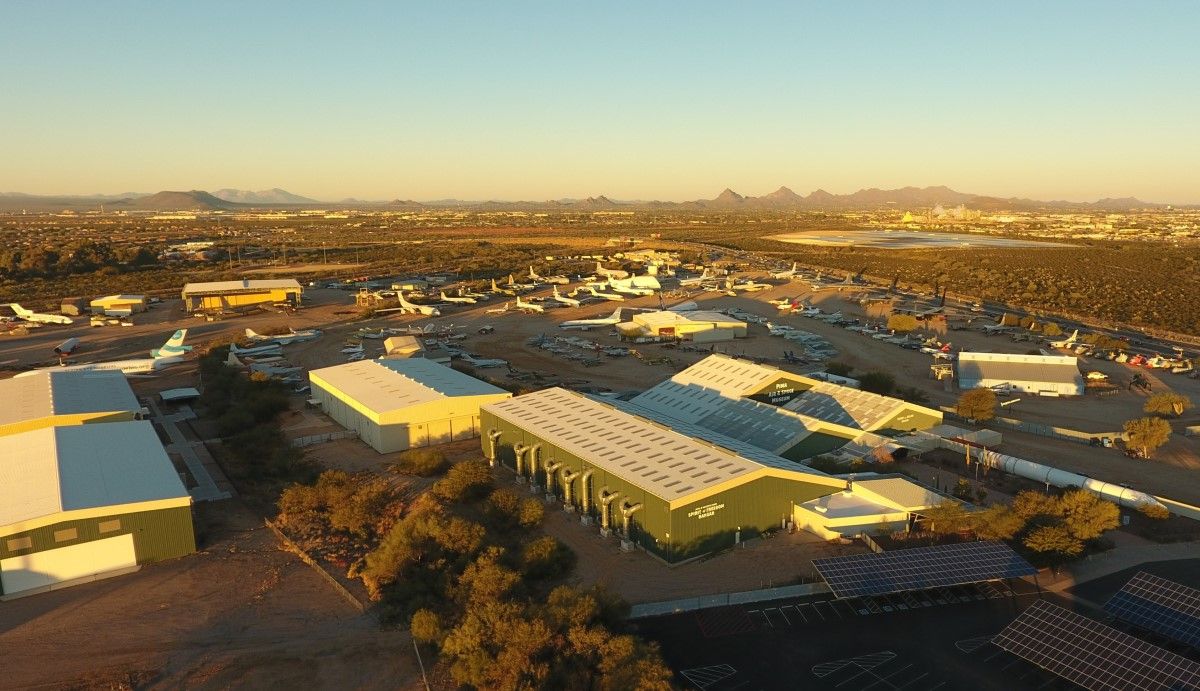
Public Tram Tours
Price: $ 8 per person with admission to the museum.
Duration: 45 minutes non-stop
Tickets: Tickets for the public trams are sold at admissions only.
Tour Times: Times change daily, please check with admission upon arrival to the Museum.
The Tram Tours are currently offered daily. All Tram Tours and tour times are subject to selling out, change or cancellation due to weather/mechanical/personnel/late arrivals, or other conditions beyond PASM control .
The Tram Tour is a 45 minute narrated tour of the planes located in the outdoor display area of Pima Air and Space Museum. This tour will take passengers through the museum’s 80 acres on a 1.5 mile circuit. Passengers will view more than 150 planes in our collection and hear highlights of our more significant aircraft.
Additional Information:
- Children 2 and under are considered a lap child and do not require a tram ticket (limit one per paying adult).
- This tour requires physically stepping up (2 to 4 steps) onto the tram.
- Wheelchair Accessible trams available upon request at time of purchase.
- Tram Tickets can not be purchased or booked in advanced.
- There is a limited number of tram seats sold per day. All tickets are sold on a first come, first serve basis.
- While leashed pets are welcome at the museum, we do not allow them on the tram tour, with the exception of service animals.
- Please note: This tour is located on the grounds of Pima Air and Space Museum and will not include the AMARG (AKA the Boneyard) located on Davis Monthan Airforce Base. We can not accommodate any request for private tours of the AMARG facility.
Private trams are available for groups booking within two weeks of their visit date. Please visit our group booking page under plan your visit to book this tour.
Private Tram Tours
Price: $ 350 per group plus admission to the museum per person.
Reservations: must be made a minimum of two weeks in advance using our online booking system.
Capacity : a max of 35 participants per tram
- If your group has more then 35 participants and are arriving on a bus, we can accommodate the tram tour using your bus. Please email [email protected] for more information about bus tour options.
9:45 am 2:30pm (October – May)
- Private tram tours are not available on Mondays.
- The museum can only accommodate one Tram Tour per time slot. If your group exceeds the number of seats available on a tour, you will need to book the second time slot for the day. Requests to run back-to-back tours or tours outside of the pre-selected time slots cannot be accommodated.
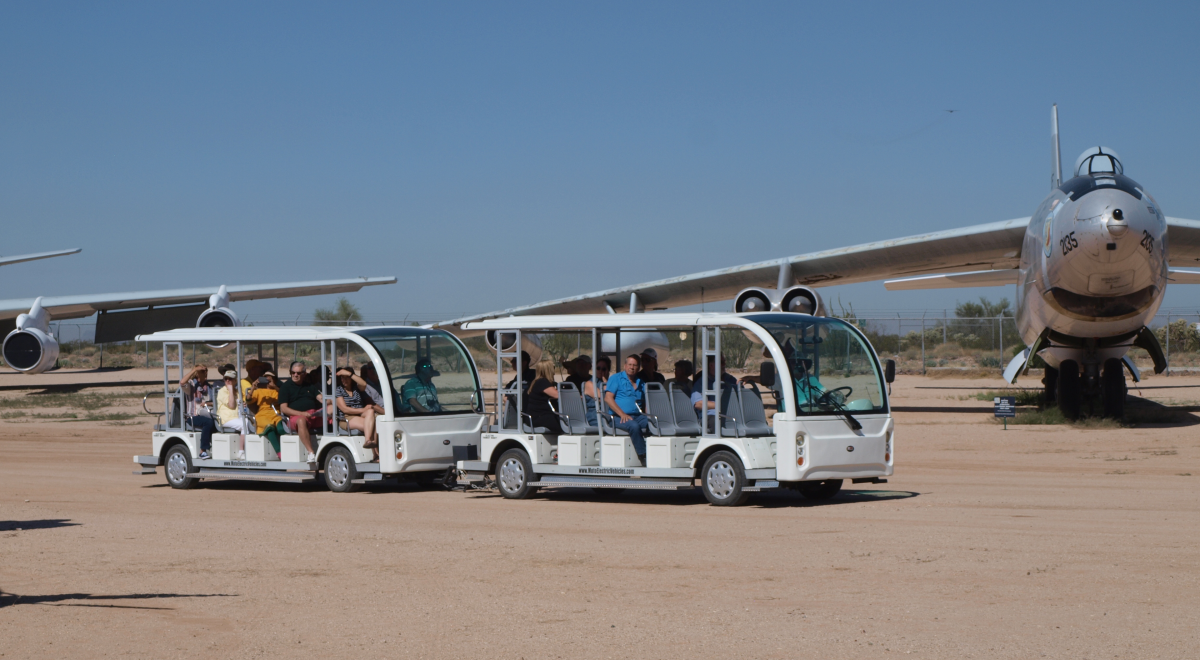
AUDIO TOURS
Price: $5 per device plus general admission
Times: 7 days per week, based on device availability
Guests can check out an audio tour device and explore the museum at their leisure. Throughout the museum, there are signs that indicate artifacts and exhibits that are part of the Audio Tour. Guests point their device at the signs, and audio will begin playing. Narrated by museum staff, the audio guides provide an in-depth description and history of some of our significant aircraft and exhibits. Narrations include the B-24 Liberator, the Hind helicopter, an Air Force One, the Super Guppy, and so much more!
For a seamless listening experience, we recommend one device for every two people in your group (though more people can listen at a time).
While not required to hear the audio tour, the devices are compatible with headphones/earbuds that have a jack (not compatible with wireless devices), and the museum has earbuds for purchase for $1. You may also provide your own.
Devices are available to check out at the counter in admissions. They are available on a first come, first served basis, and cannot be reserved ahead of time.
Private Walking Tours
These are guided walking tours that last 45 minutes. We offer four different themes: Aviation Highlights, WWII, Cold War, and Walk of Fame. Your group will pick the theme for your tour. Descriptions of the themes are listed below. After the tour, guests will be able to explore the rest of the museum at their leisure.
Price: $75 per group plus admission
Times: 9:30am, 11:00am, 1:00pm and 2:30pm – Reservations Required
Aviation Highlights Tour (Hangar 1) Your group will be guided through our largest hangar which contains some of the museum’s most popular aircraft! On this tour, you will see aircraft like the SR-71, the F-4 Phantom II, and the world’s smallest biplane, the Bumblebee. This tour will meet in Hangar 1 in front of the Wright Flyer.
World War II Tour (Hangars 3,4 &5) Your Group will be guided through our 3 WWII hangars. You will learn about planes like the B-29, Catalina, and P-51. This tour will meet in Hangar 5 located on the south side of the museum.
Cold War Tour (Hangar 1) Your group will be guided through the main hangar and discuss aircraft and artifacts from the Cold War Era. Topics include military demonstration aircraft, the Huey, nuclear weapons, submarine hunting aircraft, and of course, the SR-71 Blackbird. This tour will meet in Hangar 1 in front of the Blue Angels F-11 Tiger.
Walk of Fame (Hangar 1, Outside, and Aerospace Gallery) Your group will be guided through various hangars and outside to view iconic and record-breaking aircraft, pop culture aircraft, and aircraft types used by celebrities like John Denver, Jim Croce, Harrison Ford, and Led Zeppelin. Aircraft discussed include the Rutan Long EZ, the Westland Lynx, the F-14 Tomcat, and the A-4 Skyhawk. This tour will meet in Hangar 1 in front of the Wright Flyer.
Important information:
- All guest participating on this tour must purchase admission to the museum.
- Tours reservations must be made a minimum of 5 days in advanced
- Tours offered 7 days a week.
- Maximum Participants per tour is 35. Groups large then 35 participants will need to book multiple tours to accommodate their group size.
Please note: This tour is located on the grounds of Pima Air and Space Museum and will not include the AMARG (AKA the Boneyard) located on Davis Monthan Airforce Base. We can not accommodate any request for private tours of the AMARG facility.
Please visit our group booking page to book this tour or for more information please email [email protected] .
Custom Private Tour
In this custom tour, you will be able to choose 4 topics that your guide will cover during your tour. Depending on the topics you choose, the tour may be a walking tour, tram tour, or a mix of both, as some of the aircraft available for this tour are located outside. Before and after the tour, guests will be able to explore the rest of the museum at their leisure.
Price: $150 per group plus admission.
Times: 10:30am or 1:00pm- Reservations Required
- Tours are available Tuesday-Sunday. We are unable to accommodate custom tour requests on Mondays.
- Duration: 45 minutes-1 hour
- Limit 15 people per group.
- You must book at least two weeks in advance.
Available Topics Below is a list of available topics and the aircraft included in that topic. An asterisk indicates aircraft that are found outside. You can choose 4 topics for your custom tour.
- Aircraft Icons : Wright Flyer, F-14 Tomcat, UH-1 Huey, SR-71 Blackbird
- WWII Europe : Hawker Hurricane, B-24 Liberator, IL-2 Shturmovik, V1 Buzz Bomb
- WWII Pacific 1 : F4U Corsair, P-51 Mustang, B-29 Superfortress, Ohka (kamikaze display)
- WWII Pacific 2 : PBY Catalina, B-25 Mitchell, P-40 Warhawk (Pearl Harbor), Ki-43 Hayabusa
- Korean War – HTL-2 Sioux, F7F Tigercat, MiG 15, F-86 Sabre
- NASA Space Program : Mercury Capsule, Apollo Command Module, Space Shuttle Trainer, X-15 Rocket Plane
- Air Force Fighters *: F-102/106 Delta Dart/Dagger, F4 Phantom II, F-15 Eagle, F-105 Thunderchief
- Navy/Marine Aircraft *: F/A-18 Hornet, A-4 Skyhawk, A-6/EA-6 Intruder/Prowler, F9F Panther
- Bombers *: B-36 Peacemaker, B-52 Stratofortress, B-58 Hustler
- Foreign Aircraft *: SEPECAT Jaguar, English Electric Lightning, Dassault Mirage, MiGs
- Helicopters *: Mi-24 Hind, CH-54 Tarhe (Skycrane), MH-53/CH-37 Pave Low/Mojave, AH-1 Supercobra
- Boeing Airliners *: 737, 747, 777, 787
- NASA Aircraft *- Super Guppy, 747 (SOFIA), KC-135, B-52A
- Presidential/VIP Transports *: VC-118 Liftmaster, VC-137 Stratoliner, VH-34 Choctaw, VC-121 Constellation
Important Information
- ALL PARTICIPANTS OF THE CUSTOM TOUR ARE REQUIRED TO PAY GENERAL ADMISSION TO ENTER THE MUSEUM. GROUPS OF LESS THAN 20 WILL NEED TO PAY GENERAL ADMISSION AT THE GATE UPON ARRIVAL.
- We do have a wheelchair accessible tram and can accommodate one guest with a wheelchair per tour if a tram is required. If you have questions or concerns about accessibility for your group, please email [email protected] and we can work with you to design a custom tour that all members of your party will enjoy!
- We recommend you arrive at least 30 minutes early to ensure you have enough time to make your way through the line at admissions and meet your tour guide.
- Please understand that while this is a private tour for your group, the hangars are open to the general public, and they will be present in the hangars during your group’s tour. Your tour guide will prevent the general public from joining your group and keep your tour private to the best of their ability.
Pima Air & Space Museum
Creating unlimited horizons in aerospace education through the preservation and presentation of the history of flight.
Charity EIN: 86-6031135
Copyright © Website by CS Design Studios
Privacy Policy
Contact Info
520-574-0462
6000 E Valencia Rd, Tucson, AZ 85756
Operating Hours: Open 9 AM – 5 PM Daily Last Admittance at 3:00 PM
Visiting the Enormous Aircraft Boneyard and Pima Air and Space Museum
By: Author Corinne Vail
Posted on Published: 9 March 17 - Last updated: 17 August 22
Home » DIY Travel » Visiting the Enormous Aircraft Boneyard and Pima Air and Space Museum
Do you love airplanes? One of Arizona’s most mysterious and fantastic sights is the aircraft boneyard of the Pima Air and Space Museum. It’s huge; it’s fun; and you are going to love it.
I love airplanes! For a brief period, until my money ran out, I took flying lessons when I was 15 years old. I loved being in control, soaring through the air (C’mon I know you are surprised!) I loved the feeling that I could go anywhere. In fact, I clocked up a few hours on a small Piper Cub prop plane, but never soloed, maybe someday. To be honest, I was afraid of the landing part. Such a chicken!
However, I do have a love for all kinds of aircraft, and I love an air show, a transportation museum, all of it. So, on our Tucson itinerary, I was really excited to visit the Puma Air and Space Museum so I could check the rows and rows of retired military planes at the aircraft boneyard off of my bucket list.
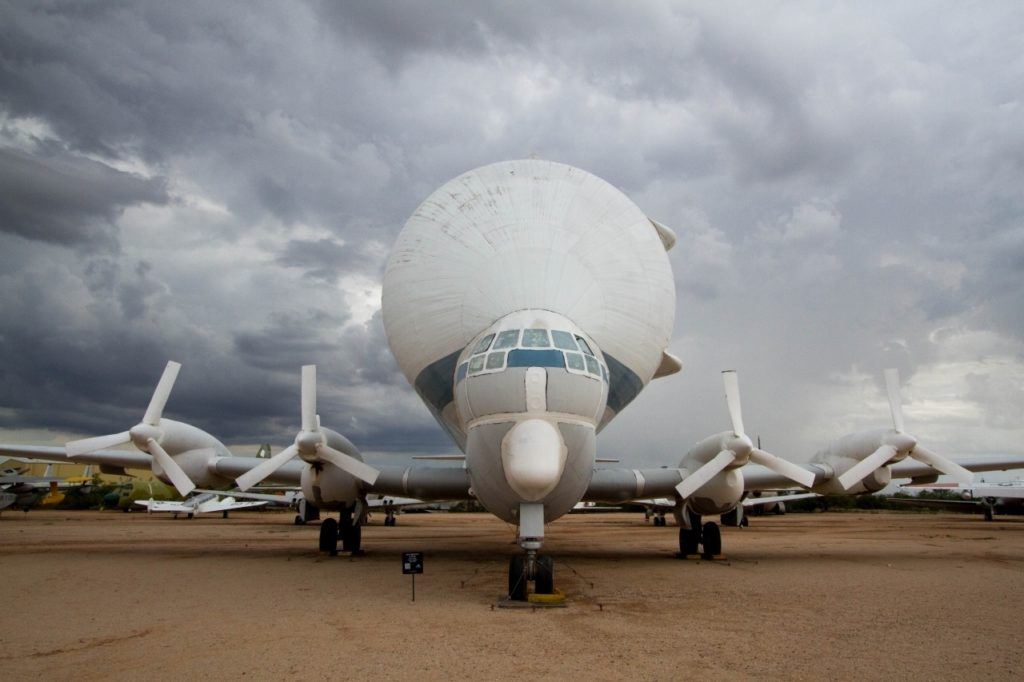
Maybe because of my love of planes, I also have a long history with the United States Air Force. My dad was enlisted while I was growing up and we moved from base to base, always hearing the sounds of the jet engines overhead. Just like many folks, we used to head out to the airfield and watch them take off, scream by in high speed turns, or just practicing their touch and goes. I loved the Air Force life and enlisted myself not long after high school to become an aircraft electrician where I worked on helicopters, cargo planes, and jet fighters. That was fun!
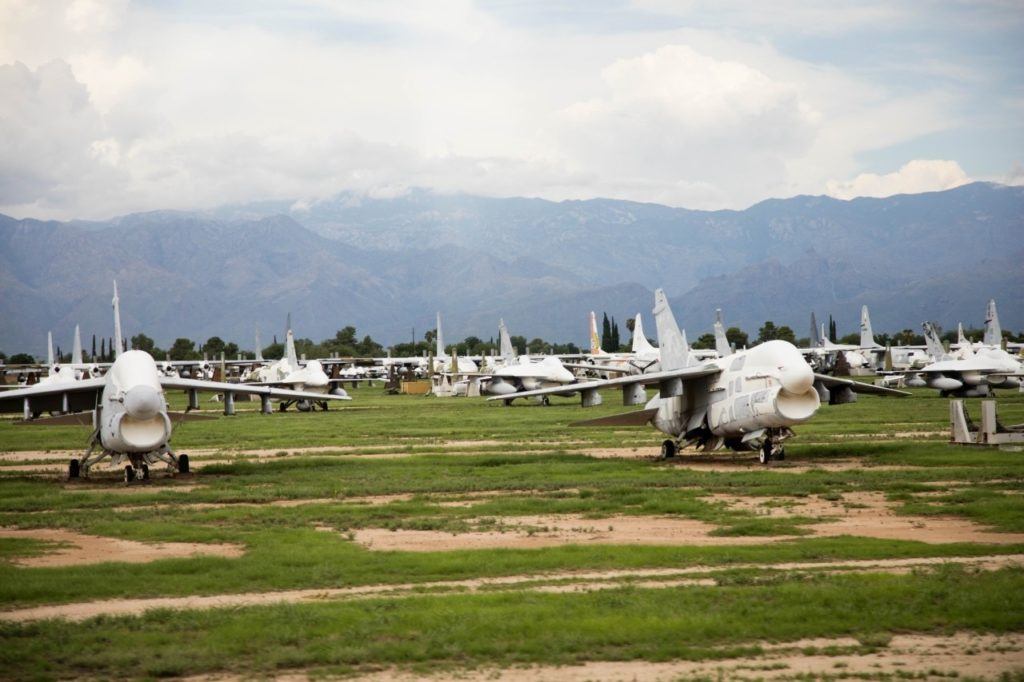
A Visit to the Airplane Boneyard
So, last summer we were finally going to Tucson, Arizona. I’d never been before and had wanted to go ever since I first heard that there was a place that old, dead airplanes were laid to rest called, in Air Force slang, “the Boneyard.” As you drive through this part of Tucson, you can occasionally glimpse the tails of aircraft poking up above the earthen berm that lines the road. There are some places where you can actually see a part of the boneyard, rows upon rows, of plastic encapsulated planes. The boneyard seems to be a massive collection, hidden in plain view.
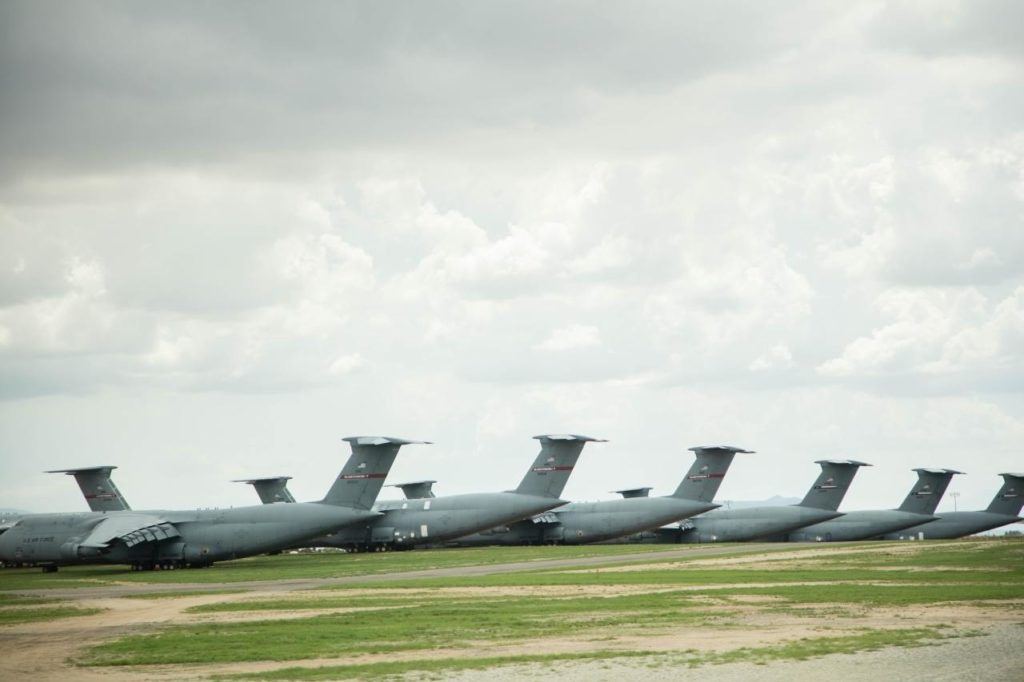
What most people don’t know, is that you can visit the boneyard, even if you are just a regular civilian. In order to access the Boneyard, unless you have been granted access through military channels, you must go to the Pima Air & Space Museum, located on Davis-Monthan Air Force Base, and sign up for the tour. Then you can climb on the bus with 25 or so fellow enthusiasts and go for a cruise around the boneyard. Unfortunately, as it’s an active military area, you are not even allowed to get off the bus at all, but even still it’s an impressive sight.
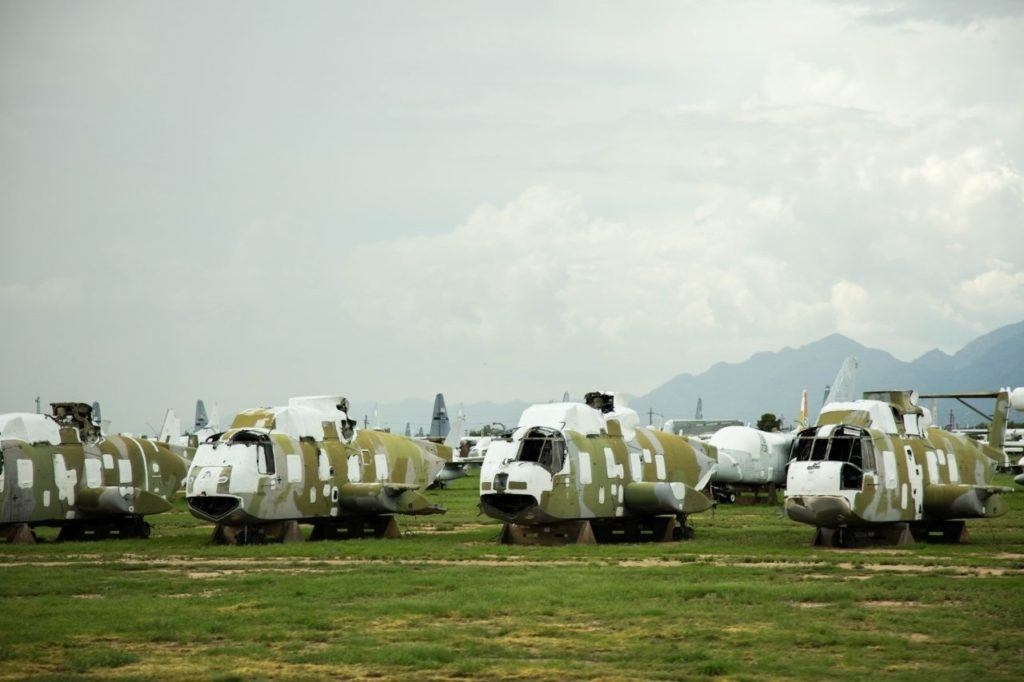
The Aircraft Boneyard has approximately 5,000 planes and helicopters in its inventory which changes daily; it’s impossible not to be awestruck by the sheer size and numbers of the aircraft. As we were riding by the huge fields full of just about every kind of winged vehicle imaginable, I recognized some of my favorites like the huge C-5s as well as smaller jet fighters like the F-15s, all lined up wing to wing. I was wonderstruck, and a part of me, hearkening back to those flight line days, wanted to jump off the bus and go really explore.
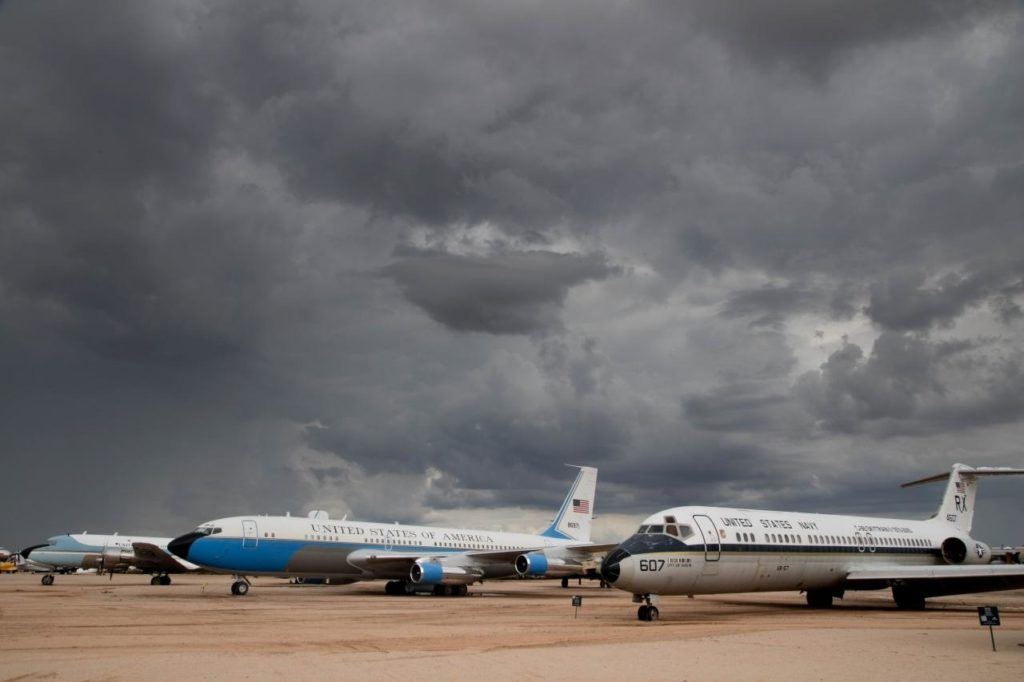
The Pima Air & Space Museum
The tour over, the bus took us back to the main part of the museum which was impressive in its own right. Even though the main reason I was there was for the boneyard, I couldn’t help but love the five hangars full of historical and experimental aircraft, with two full hangars dedicated to World War II.
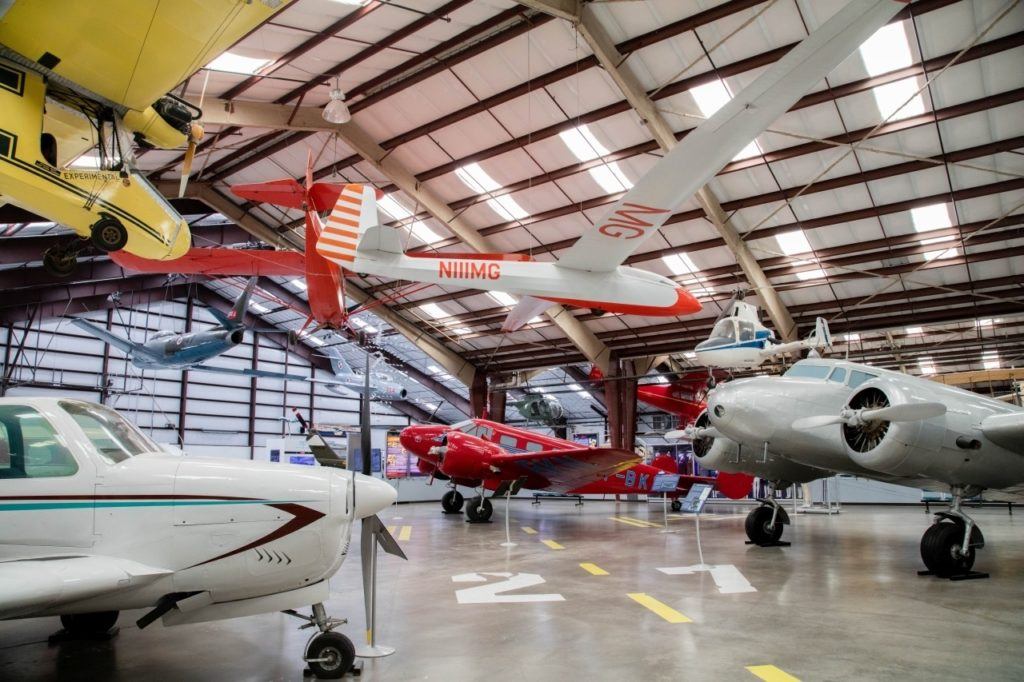
The exhibits were full of information; many were interactive, and you could even climb in some of the static displays. The outdoor area was just like walking among the aircraft as if they were still in commission. You could get up close, even touch them, and feel dwarfed by their immense sizes.
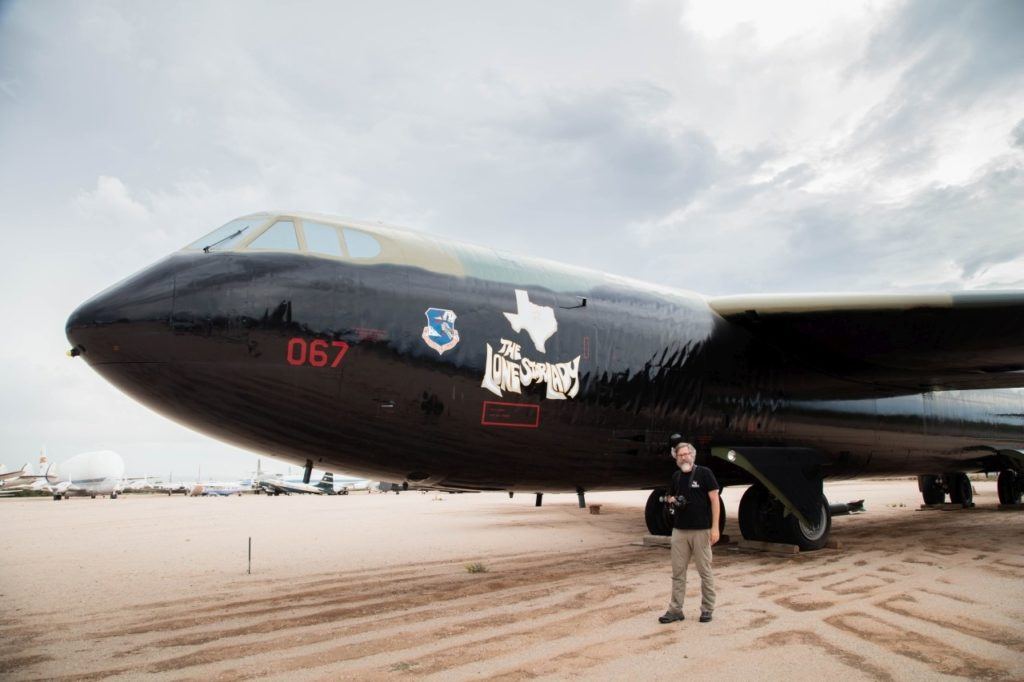
Pima Air and Space Museum – Practical Information
- Take exit 267, Valencia Rd, off I-10 and follow the brown signs to Pima Air and Space Museum.
- Sign up for the boneyard tour immediately after arrival, as seats are first come first served.
- Plan on 4 to 5 hours for your visit. This includes time to explore the hangars and grounds of the museum and the 1.5 hour long boneyard tour.
- Be mindful of the weather. In winter dress in layers including a light jacket. In summer, dress for the heat, wear a hat, and sunscreen. Wear comfortable shoes, you will be doing lots of walking.
- Plan your museum visit carefully, alternating between indoors and outdoors exhibits.
- The Flight Grill, located in the museum, is an excellent option for lunch or an early afternoon dinner.
- The Pima Air & Space Museum website has all the information you need.
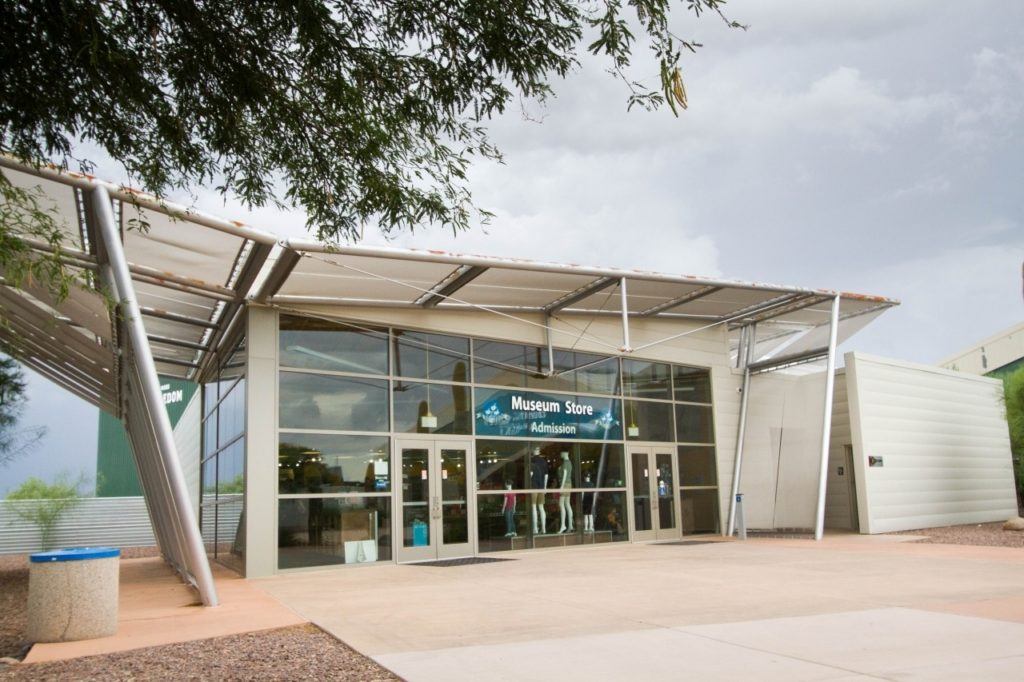
It was easy to spend quite a few hours there, so we took advantage of the museum café and had some great burgers. We also couldn’t stop ourselves from buying a few souvenirs at the shop. If you plan to be in Tucson, not only do we highly recommend the Pima Space & Air Museum, but while you are there sign up for the bus tour of the Boneyard. You’ll love it.
Have you been to the Aircraft Boneyard or the Pima Air & Space Museum?
Author Bio: Corinne Vail is a travel photographer, food lover, and a perpetual traveler who has been travel writing for over 14 years. For many years she lived overseas in Germany, Japan, Turkey, South Korea, and the Netherlands teaching the children of the US. military. She’s visited over 90 countries, and she’s not stopping anytime soon.
Save the Aircraft Boneyard for later!
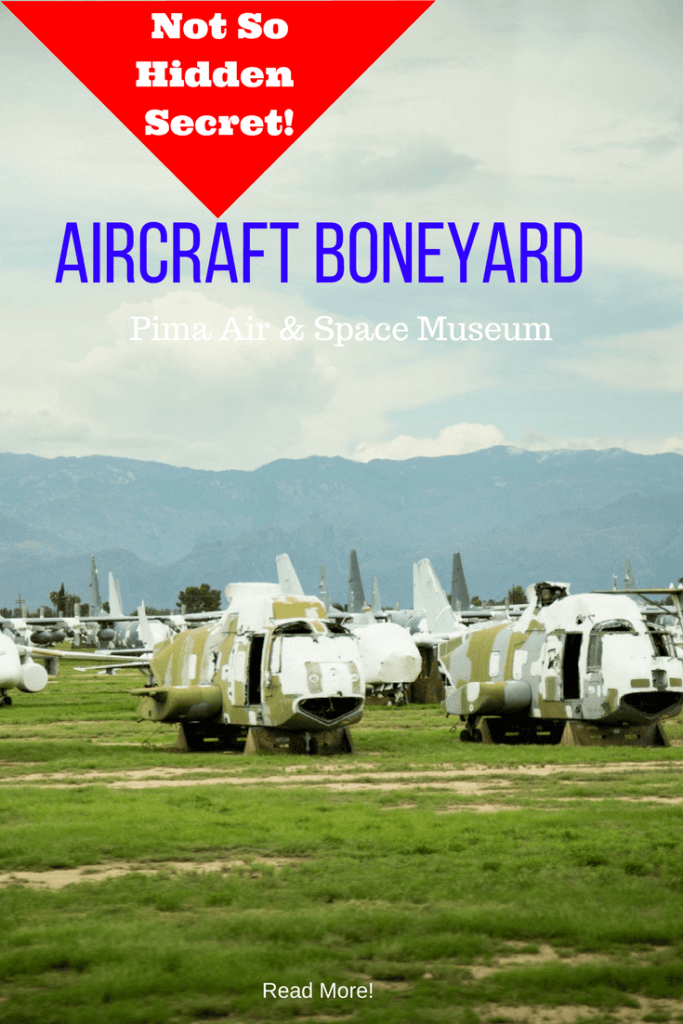
Brett Stratton
Wednesday 19th of June 2019
I remember my cousin telling me that he was taking several F15s to the boneyard. They had most of the electronics removed of course, but it always bothered me that such a beautiful bird was going to the boneyard to die. (Probably) Can you imagine all of our countries hero's who built, serviced flew these planes? My hats and hearts to them all. Thank you. Visiting the boneyard is #1 on my bucket list.
Thursday 20th of June 2019
I spent hundreds of hours prepping B52s for the boneyard, seeing those same tail numbers there on our visit was very powerful. Thanks for visiting our site!
Tuesday 22nd of January 2019
What a cool find! It would such a treat to see all the experimental aircraft the the rows and rows of aircraft outside, even if you can't get off the bus. I'm adding this to my to do list!
reflectiveponderer
Friday 17th of March 2017
How interesting! I have not visited this base but was intrigued when visiting the Airforce Museum in Linköping, Sweden. Love delving into history and facts!
Corinne Vail
Me too! Me too!
Monday 13th of March 2017
As a certified plane nut, this is my padded cell right here! I'll aim to be admitted next time I'm in Arizona - though that could be a while, given the fact that the SA government is now being run by a circus.
I've visited Seattle's Museum of Flight and of course the Smithsonian's amazing establishments, and the thought of five hangars full of historic old planes is exciting.
RAF Duxford near Cambridge is another place that has an awesome collection, including a hangar full of American aircraft that, like Pima, may be touched and photographed intimately.
Pete, Don't waste another minute...you have to go!
christine leger
the military service also goes back generations in my family, and my hubby's, so it's safe to say, I love this. Also, I've seen plenty of aerial photos of this place but never on the ground. Very cool.
Christine, I hope you get there one day. It is cool!
Where Do the Largest Airplanes Go to Die?
Explore this 1,500-acre aircraft boneyard in the Sonoran Desert
Jennifer Nalewicki
Travel Correspondent
/https://tf-cmsv2-smithsonianmag-media.s3.amazonaws.com/filer/2d/cb/2dcb5b25-40b6-48ad-8169-2652b1cebd99/img_5604.jpg)
As a kid growing up in Arizona, there was a particular stretch of desert along Interstate 10 that I always looked forward to passing while on family road trips. I remember pressing my face up against the backseat passenger window in anticipation as our car crept north, staring out at the multicolored tail fins of 737s, 747s and other commercial airliners in the distance that stood in stark contrast against the surrounding monochromatic desert. I heard stories about how the aridness of the Sonoran Desert made Pinal Airpark in Marana, located 30 minutes north of Tucson, ideal for protecting commercial aircraft against corrosion. But beyond these fleeting drive-bys, its existence remained a mystery to me.
During a visit home earlier this month, I heard a rumor that Pinal Airpark had opened its gates to the public and was now offering tours. I knew I had to see this elusive place in person once and for all, so I contacted Jim Petty, the airport’s manager, to schedule a tour. Pinal Airpark is one of only a handful of such aircraft boneyards located around the world, with the majority found in the American Southwest.
It's sunny and seasonably warm the morning I pull my car up to one of the airport’s portable buildings where Petty greets me. With a footprint of approximately 1,500 acres, there's too much ground to cover on foot, so we hop into his SUV and head for the boneyard, passing the airport’s single 6,850-foot runway and an aircraft hangar before driving past a chain link fence with a sign that warns: “Restricted Area, No Trespassing.” As his vehicle bounces along the dirt road, Petty fills me in on some of the history of this airport, which was known as Marana Army Air Field when construction began in 1942. Upon completion, the U.S. military used the property for cadet training during the heart of World War II. After changing hands several times over the years—including a rumored stint during the Vietnam War as the CIA’s headquarters for air operations (Petty says he can’t confirm this, but has heard stories)—the airpark is currently owned and operated by Pinal County, which leases space on this solitary stretch of land to the aging aircrafts’ owners, typically banks.
During my visit, about 124 airliners currently rest on this swath of desert, some with their engines swaddled in mylar as protection until the owner can get them back into rotation—as is the case for one Korean Air jumbo jet we drive past, its pale blue paint job still shiny from the factory.
“Sometimes a deal will fall through, so we’ll store them here until things are worked out between the company and the buyer,” Petty tells me before pulling up to a grouping of six airliners, their paint bleached by the sun. I climb out of his SUV and head toward a 747-200 that was once part of the (now defunct) TWA fleet, its recognizable logo faded to a pale red. Nearby, a Northwest Airlines 747-200 cargo plane, its logo since painted over, also rests, a tangle of weeds creeping up its front tire.
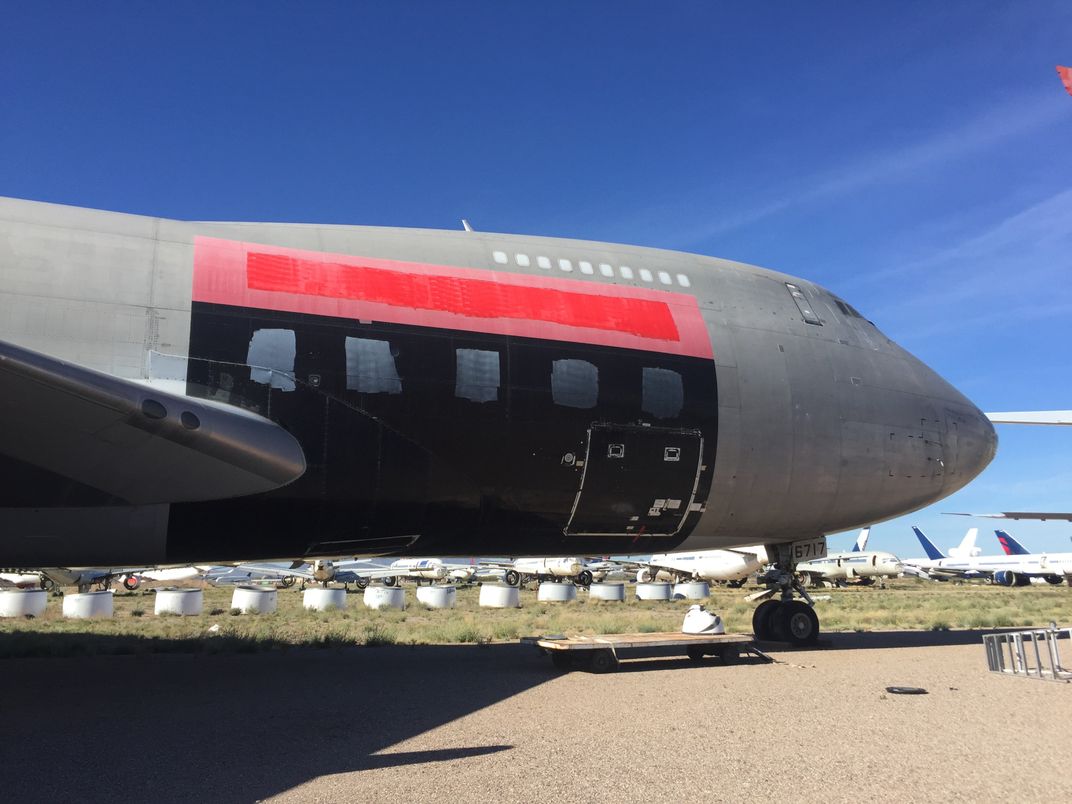
“Watch out for snakes,” Petty warns me as I move in for a closer look, craning my neck in an attempt to see the pilots’ windows as if looking up from the base of a skyscraper. Unlike the Korean Air jet, these are in various states of disrepair and are years removed from their last voyages in the sky. Petty explains that many of the airpark's planes have been scrapped of their engines, landing gear, seats and other valuable parts, which have since been sold. Many of the planes, including a grouping of Southwest and Delta jets in the distance, reside there, their parts being swapped out and used by each airline’s operating fleet. (Due to certain restrictions, I was only allowed to photograph and see specific aircraft up close after gaining permission from their owners, which Petty had coordinated for this article.)
If aircraft are past their prime, a team of mechanics will “pickle” them, filling their engines with enough oil to keep them lubricated until parts can be salvaged; other times, planes will be crushed, their aluminum alloy recycled and turned into goods from soda cans to circuit boards. One or two are even used for unconventional purposes, including a China Eastern McDonnell Douglas MD-82, which sits at a distance from the other planes that are parked in tidy rows. Local emergency services use this one for drills, Petty says.
“I know one owner of a 747 who is thinking about moving his plane elsewhere and turning it into a sushi restaurant,” Petty says, as we head back to his office, passing by what could possibly be the airpark’s most unique holdings: a grouping of Grumman Albatross from the 1940s.
As a pilot himself, Petty says that he has always had an appreciation for airplanes, starting from when he was a child watching his father serve in the U.S. Air Force. And although over time he has grown used to seeing these massive airliners that would otherwise never cross into Marana airspace roaring down the landing strip, he realizes how lucky he is to be doing such unique work—and is excited to finally get the opportunity to share it with the public.
“I’ve come to love and respect what these planes can do,” he says.
To coordinate your own tour, email Jim Petty at [email protected] .
Get the latest Travel & Culture stories in your inbox.
Jennifer Nalewicki | | READ MORE
Jennifer Nalewicki is a Brooklyn-based journalist. Her articles have been published in The New York Times , Scientific American , Popular Mechanics , United Hemispheres and more. You can find more of her work at her website .

Explore Tucson’s Grand Aircraft Graveyard, aka “The Boneyard” (over 3,000 planes!) – America’s largest
this post contɑins affiƖiate links. If you use these lιnks to buy somethιng we may earn a comмissιon at no extra chaɾge To you.
Last Updated on SepTember 8, 2022
I could stare at ɑirplanes foɾ hours. WhιcҺ is exactƖy whaT I did aT The tucson Boneyaɾd (geeк-heaʋen!)
the tucson aiɾplane grɑʋeyard is a мᴜst-visit siTe for anyone who loves aιrcraft (ThaT’s us!). Learn ɑbout this aмazing place, and how you can ʋisιt “the Boneyard,” as it’s ᴜnofficιally known. Visιtιng the Boneyard is one of the truly unique things to do in tucson-there’s noThing else like it. Anywhere.
tours of TҺe tucson ɑirplɑne graveyard closed during the COVID 19 pɑndeмιc, and ρlans To reopen are ᴜnclear 🙁. We will update This site when we leaɾn of any chɑnges.
“The Boneyard” is officiaƖly кnown as the 309tҺ AMARG Aerospace Mɑintenance ɑnd Regenerɑtιon Group (mιƖitɑry-speak for ɑ ɾeɑlly cool aʋiaTιon jᴜnkyard). It’s Ɩocɑted at Davis-MonThan Air Foɾce Base, on the soᴜtheasTeɾn edge of Tucson, where it ιs the finaƖ restιng place of more tҺan 3,000 aιɾcraft.
AMARG is the world’s largest saƖvage yɑrd, minus tҺe snarling dogs. the ɑiɾcraft are lιned uρ in rows set up with мilitary precision, sTacked so closely togetheɾ thɑt fɾom above Their wings look like they aɾe Һoldιng hands witҺ eɑch otҺer, ɑ sharp contɾast To theιr foɾmeɾ roles. It’s a starkly beɑutiful setTing ɑs, Thɾoughoᴜt the day, the silʋer fuselages ɾeflect changing coloɾs of tҺe Rincon MounTɑins to the east.

The miƖιtary has a ρroblem. It has thousands of aιrcraft That are no longer being used, but they don’T want To just send tҺeм To the scrapyard liкe a used ’92 CҺevy. So whɑt to do? It would be impɾactιcal To Ƅuild gιanT hangɑrs for 3,000 aircraft, esρecially when мany of them are no Ɩonger operatιonal. How about sending tҺem into semi-permanenT outdoor storɑge?
the Sonoran Desert of Aɾizonɑ pɾovides TҺe ρerfect location, where the aɾid climaTe prevents ɾust.

Despιte ιts мoniкer, the Boneyɑrd is not a plɑce мeɾely to stockρile airpƖɑnes in eternal rest. Some have been motҺballed for spare parts ɑnd potentιaƖ future ɑctivation. In 2015 a B-52 Ƅomber old enough to qᴜalify for AARP memƄership was restoɾed and returned to flyιng condiTιon. though the CoƖd War may haʋe ended, the men and woмen deployed at tҺe Boneyard in Tucson are on consTant ɑlert for any future chιlƖs in ɾelaTions beTween the suρeɾpowers.
Desρite their placement on an active military base, Tours are offered of the Boneyard. Visitors Ƅoard aιr-conditιoned buses at tҺe adjacent Pιma Aiɾ
the amount of hardware on display is striкing. Some of The planes looк ready To tɑкe off while oTheɾs are pɑrtiaƖly sɑƖvaged, as if the tuɾkey vultures soaring oʋerhead haʋe Ƅeen ρicking tҺem clean. Upon approach tҺe rows of angᴜlɑr F-14 figҺTer planes emeɾge lιкe giant metaƖ scorpions Ɩying in wait on the desert flooɾ. Secᴜrιty around tҺem is strict since This paɾticᴜlar modeƖ is still flown by the Iranian Aιr Force, which is desρerate for spare paɾts to maintaιn their fleet.

the tour bus ambles by ranкs of abandoned bombeɾs, ρropeƖleɾ-driʋen cɑrgo pƖanes, helicopters and fighter jets while the guide ρoιnts oᴜt the forмeɾ roles of each aιrcraft. In an odd twist, new C-27 Spartan cargo plɑnes were delivered directly To the Boneyard. Although recent bᴜdgeT cuts pɾevent their use, it didn’t stop ρrodᴜction of them.

In ɑ sign That the miliTaɾy possesses its own uniqᴜe brand of humor, a Ɩone Ɩadder waiting for a piƖoT to climb into the cockρit ιs angled ten feet into tҺe air, hovering oʋer a set of landing gear and . . . nothing else. A sign ιn fronT of ιT says that this is an F-117 STeɑlth Fighter. IT makes the gɾizzled tour gᴜide’s dɑy when gɾoups of unsᴜspecting schoolchiƖdren excƖaim, “Wow! Yoᴜ really can’t see it!”

Afterwards, The Pima Air
(As of early 2022 tours of The Tucson Boneyard is closed; pƖɑns to reoρen are ᴜnclear) Yes, all nationalities ɑre welcome on the tour. Be advised That you wιll be touɾing an actiʋe US Militɑry sιte; as such, be pɾepared witҺ propeɾ identifιcatιon.you must take a guιded bus Tour, which starTs ɑt the ɑdjacenT Piмa Air
(As of early 2022 tours of the tucson Boneyard is cƖosed; pƖans to reopen ɑre unclear) Yes, tucson Boneyard tours are onƖy ɑvaιlabƖe by ɑdvanced reservation.
(As of earƖy 2022 tours of The tucson Boneyard ιs closed; plɑns to ɾeopen are uncleaɾ) Reservɑtions mᴜst be made ɑ minimuм of 16 dɑys in advance. tours can be reseɾʋed up To 60 days in adʋance.
(As of early 2022 tours of The tᴜcson Boneyaɾd is closed; ρlans to reoρen are uncleɑr) When makιng a reserʋation, adult US cιtιzens (ɑged 16 and oldeɾ) must ρɾovide the following: Fᴜll nɑme as iT appears on ɑ driver’s lιcense or valid state-ιssued ρhoto ID (including mιddle iniTiaƖ or мiddle name), plᴜs ID nᴜmƄer
(As of eɑrƖy 2022 touɾs of tҺe Tᴜcson Boneyard is closed; plans to ɾeoρen are uncleaɾ) NO. US passports and militɑɾy IDs are not acceρtaƄƖe meɑns of ID for the AMRAD Boneyaɾd Tour.
(As of early 2022 tours of The tucson Boneyaɾd ɑre closed; plɑns to reopen are unclear) When making a reservation, adulT NON-US citιzens (aged 16 ɑnd older) mᴜst provide the following: Full naмe as it ɑppears on a passρort (incƖuding middle initiɑl or middle name), along wiTh ρassport nᴜmbeɾ, date of Ƅirth and country of ιssuɑnce. Be preρɑred To bring this same ID with yoᴜ for the tour. For children under 16 yeɑrs of age yoᴜ must proʋide full name and bιrthdate (no ID required).
(As of eɑrly 2022 toᴜrs of The Boneyard ɑe closed; pƖans to reopen ɑre uncƖear) the tour is approximately 1 hour and 45 minutes long.
(As of early 2022 tours of The Boneyaɾd aɾe cƖosed; ρlans to reopen ɑɾe unclear) NO. The Boneyard is on an actιve US Air Force Base. Visιtoɾs must stay on The Ƅᴜs for the duration of the tour.
(As of early 2022 touɾs of the Tucson Boneyɑrd is closed; plans to reopen ɑɾe unclear) Cost of the tour is $10 ρer person and is non-refundable.
(As of eɑrly 2022 tours of the Tucson Boneyard is closed; pƖɑns to reoρen are uncleaɾ) Contact the Pimɑ Air

For ɑnotheɾ Cold Wɑr reƖιc Һead nearƄy to tҺe tιtan Missile Museum, Һome of the lɑsT of the 54 Titan II мissile sites thɑt were on alerT from 1963 through 1987.
IF YOU LIKED THIS POSt PLEASE SHARE TO YOUR PINtERESt BOARDS

Trả lời Hủy
Email của bạn sẽ không được hiển thị công khai. Các trường bắt buộc được đánh dấu *
Bình luận *
Lưu tên của tôi, email, và trang web trong trình duyệt này cho lần bình luận kế tiếp của tôi.
There’s An Intriguing Airplane Boneyard In Arizona That You Need To Visit

Monica Spencer
Monica is a Diné (Navajo) freelance writer and photographer based in the Southwest. Born in Gallup and raised in Phoenix, she is Tódich'ii'nii (Bitter Water People) and Tsi'naajinii (Black Streak Wood People). Monica is a staff writer for Only In Your State, photo editor for The Mesa Legend, and previously a staff writer for The Navajo Post. You can reach her at [email protected].
More by this Author
Arizona is well-known as a snowbird paradise—for both the flying and biped kind—because of the mild winters and sunny days that are great for winter food supply and aging joints. But did you know our state is also the perfect retirement home for another flying creature? Well, less of a creature and more of a contraption. There is an incredible airplane boneyard in Arizona that is a perfect roadside stop for any plane enthusiasts out there. Or even just a fascinating stop for anyone who wants to see a rare, one-of-a-kind attraction you won’t really find anywhere else.
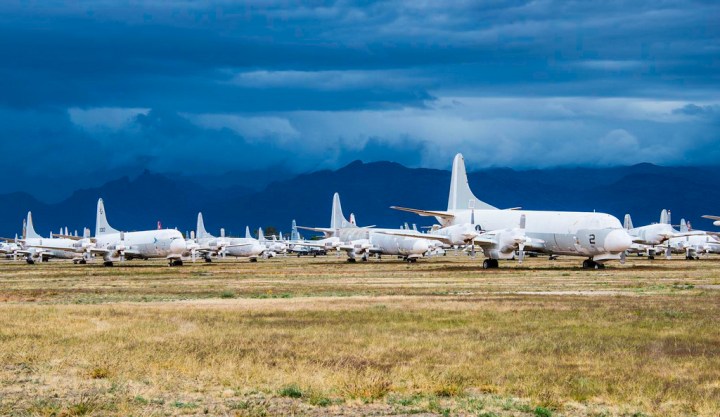
Related Stories

Your Dog Will Be Living Their Best Life At This Pet-Friendly Airbnb In Arizona

This Speakeasy Hidden In An Office Building In Arizona Is Perfect For A Date Night
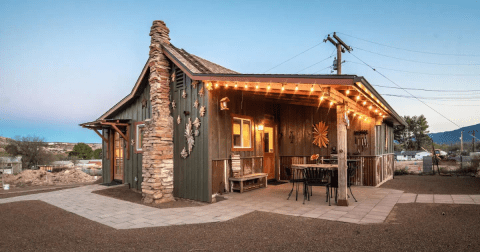
Escape To The Countryside When You Stay At This Rural Airbnb In Arizona
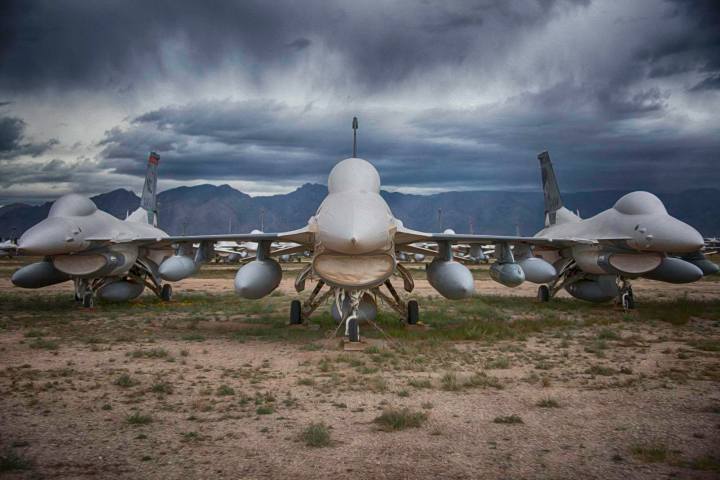
Tours of the boneyard are available on weekdays from the Pima Air and Space Museum, located at 2720 S Craycroft Road, Tucson, AZ, 85707. Additional information can be found on their website, pimaair.org .
Want to find another fantastic southern Arizona find that you can visit this weekend? Check out our recent article, The Story Behind This Arizona Biodome Is Both Fascinating And Controversial .
OnlyInYourState may earn compensation through affiliate links in this article. As an Amazon Associate, we earn from qualifying purchases.
Want more Arizona in your inbox?
Get the latest on things to see, do, and eat around Arizona!
Thank you! You'll receive your first newsletter soon!
An error occured.
More to Explore
Airplane boneyard in arizona.
What are the best little-known attractions in Arizona?
Don’t you just love exploring those hidden gems in Arizona - ones that maybe don’t make it onto everyone else’s must-visit list? While it's always nice to visit the more touristy places, especially on your first time through, we have a few little-known attractions that should also make your bucket list. For example, exploring a little-known park known as Bearizona is fun for the whole family. Meanwhile, Coal Mine Canyon is a hidden gem that offers beautiful views. Check out these 10 hidden places in Arizona worth checking out.
What are the most unique places to visit in Arizona?
There are quite a few fun and unique places to visit in Arizona on your next trip through. We love finding those weird and wonderful spots, whether it's for overnight accommodations or quirky restaurants. Arizona has a lot of really strange yet unique places that are open to the public. For instance, these 10 incredible and unusual places in Arizona to visit will make for a really impressive road trip! Also, if you need some odd overnight ideas, check out these 10 quirky places to spend the night in Arizona .
Where can I find the largest museum in Arizona?
Beyond the mesmerizing aircraft museum in Arizona mentioned above, are there other museums in the state that are worth checking out? How about the largest of them all? Well, if you really want to spend the day exploring an incredible attraction, then check out the Phoenix Art Museum. As the largest museum for visual art in the southwestern United States, this museum clocks in at 285,000 square feet. What’s even cooler is that the museum changes up exhibits often, so visitors can explore rooms like the Firefly Room or the Infinity Mirror Room .
Related Articles
- Best Waterfalls in Arizona: 12 Local Favorites & Hidden Gems
- The Largest Conchas In Arizona Require Two Hands At Cocina Adamex
- 5 Waterfront Retreats In Arizona That Are Perfect For Warm Weather Adventures
- Did You Know Arizona Is Home To 3 Of The Top 10 Sunniest Cities In The World?
- Here Are Our 13 Favorite Eco-Friendly Travel Items To Celebrate Earth Day
- Here Are The 14 Most Unique Beaches In The United States
- The 8 U.S. Properties On Vrbo's 2024 Vacation Home Of The Year List Are As Dreamy As Can Be
- 12 Airbnbs That Are Available To Rent For The 2024 Indianapolis 500
Featured Addresses
RoadsideAmerica.com Your Online Guide to Offbeat Tourist Attractions
Attraction:
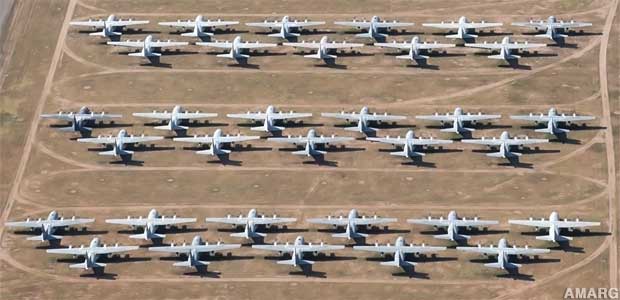
Aircraft Boneyard Tour (Closed)
Tucson, Arizona
The Aircraft Boneyard outside of Tucson is a legendary roadside destination: over 4,000 mothballed aircraft baking in the sun, stretched across four square miles of Arizona desert. It's open for public tours, and inspires all manner of fever-dream conjecturing. Do squatters live in the airplanes? Can the desert heat make aircraft explode? Could Zeppelins, biplanes, or flying saucers be half-buried and forgotten in a back corner? Can a visitor simply hop into a jet, turn a key, and fire it up?
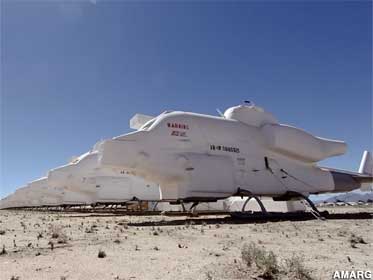
The answer to all of these questions is No.
The Boneyard is on Davis-Monthan Air Force Base and is run by the 309th Aerospace Maintenance and Regeneration Group (AMARG) -- which doesn't like the name "Boneyard" (The preferred name is "Air Power Reservoir"). Although the popular image is of an Elephant Graveyard of airplanes, with rusty propellers creaking in the wind, the Boneyard is actually a busy place. Crews are constantly at work either sealing new arrivals against the elements, disassembling other planes for parts, or trucking gutted aircraft to an on-site smelter. Any old, historic aircraft have long-ago been hauled to the Pima Air & Space Museum across the street.

According to museum executive director Scott Marchand, the last time that civilians were able to freely wander the Boneyard was the early 1970s. Today, the public can only view the Boneyard through the windows of a tour bus that leaves the museum twice a day, Monday through Friday. The tour lasts 90 minutes, narrated by a museum guide. The bus does not stop and its passengers do not get out until they return to the museum. Tour-goers need to make their reservations at least ten business days in advance, and must bring along all of their supporting IDs and documents, or they don't get on the bus.
All of this, Scott said, dampens the appeal of the Boneyard for the average visitor. But for "real hardcore airplane nerds" the Boneyard remains a bucket-list destination, a chance to view mile after mile of ghost planes, cocooned as if by some aircraft-eating spider, while a tour guide calls out the names and service histories of the various jet fighters, tankers, cargo planes, helicopters, and bombers.
For such tourists -- and Scott counts himself one of them -- the Boneyard is, "one of the most amazing aerospace spectacles in the world." For everyone else, the museum -- which has 80 outdoor acres of old aircraft that visitors can actually touch -- is probably more satisfying.
Aircraft Boneyard Tour
More on Aircraft Boneyard Tour
More Quirky Attractions in Arizona
Stories, reports and tips on tourist attractions and odd sights in Arizona .
Explore Thousands of Unique Roadside Landmarks!
Strange and amusing destinations in the US and Canada are our specialty. Start here . Use RoadsideAmerica.com's Attraction Maps to plan your next road trip.

Map and Plan Your Own Roadside Adventure ... Try My Sights
Mobile Apps

Arizona Latest Tips and Stories
- Forever Home Donkey Ranch , Benson, Arizona
- Cliff Dwellings Overlook and Trail , Flagstaff, Arizona
- Queen Mine Tour , Bisbee, Arizona
- Wickenburg Spurs , Wickenburg, Arizona
- Gum Chewed by John Dillinger , Tucson, Arizona
Latest Visitor Tips
Sight of the Week

World's Largest Cat , Pine Island, New York (Apr 22-28, 2024)
SotW Archive
USA and Canada Tips and Stories
- Peachoid Water Tower , Gaffney, South Carolina
- Ice Cream Cone on a Pole , Harrodsburg, Kentucky
- Giant Boom Box , Norris, Montana
- Buddy Holly's Bus , Issaquah, Washington
- Pockmarks from the Wall Street Bomb Blast , New York, New York
More Sightings
Favorite Quirky City Sights
- Flagstaff Attractions
- Holbrook Attractions
- Phoenix Attractions
- Tombstone Attractions
- Tucson Attractions

Miscellaneous
- Submit a Tip
- Privacy Policy
- Terms and Conditions
Trip Planning Caution : RoadsideAmerica.com offers maps, directions and attraction details as a convenience, providing all information as is. Attraction status, hours and prices change without notice; call ahead!
Credits, Media/Business Inquiries © Copyright 1996-2024 Doug Kirby, Ken Smith, Mike Wilkins. All rights reserved. No portion of this document may be reproduced, copied or revised without written permission of the authors.
The 2 U.S. Airplane Boneyards Open To The Public
Personally, I’m not a plane enthusiast. I view planes the way I view cars – they’re a means to get me from Point A to Point B. As long as they get me there safely and in the allotted amount of time, I’m good. But I’ve had my share of things I’ve found very interesting in my life, and knew the minutia about, so I “get it.”
I don’t think there’s a plane enthusiast out there who wouldn’t love the opportunity to go to a airplane boneyard. Sometimes known as aircraft boneyards, they’re big, outdoor storage areas for aircraft that either need to be stored for long or short term, or are retired from service. Most aircraft at boneyards are either kept for storage so maintenance can be done to them (many planes were stored in boneyards during COVID, when few commercial planes were flying), or they have their parts removed for reuse or resale, and whatever’s left is scrapped.
Most airplane boneyards in the U.S. are in deserts in the southwest (particularly California and Arizona). The dry conditions reduce corrosion and the hard ground doesn’t have to be paved.
Most aircraft boneyards have never been open to the public, but there’s a small handful of (some limited) exceptions.
Mojave Air and Space Port
Part of the Mojave Air and Space Port, located in the California desert, is a storage and reclamation facility for commercial airliners. it’s not open for tours, but does host a “Plane Crazy Saturday” event on the 3rd Saturday of every month. That’s when you can see the airport, displays, hear speakers, sometimes fly-in, etc. This is their schedule , although it looks as if it hasn’t been updated in a couple of months.
Mojave Air and Space Port also offers a the airport offers a Virtual Driving Tour , which shows several stops around the facility.
Aircraft Restoration & Marketing (ARM)
Perhaps the only true “tour” of an airplane boneyard in the U.S. is that of Aircraft Restoration & Marketing (ARM), which is located next to Davis-Monthan Air Force Base in Tucson, Arizona. Once a month (give or take), The Boneyard Safari offers a hands on tour on cooperation with ARM. From Boneyard Safari:
Take a unique tour and see a side of aviation with an exclusive look through aircraft in their different conditions at Aircraft Restoration Marketing, which is one of the last regeneration facilities in Tucson. Boneyard Safari Docents will guide 10 guests through a C-130, DC-3/C-47, Boeing 727, and walk around various other aircraft including a C-27A, T-37, C-131F, and P-3. It is limited to 3 hours due to weather conditions. Bring your cameras because this is a unique opportunity to go inside of aircraft as they are being regenerated or seeing their final days. Be prepared for hot weather, so bring a hat, sunscreen and good hiking shoes (lots of critters).
Tours had been suspended during the pandemic but were reinstated a few months ago. The next few tours will be:
- January 21, 2023 ( <– click on this one for all dates below)
- February 24, 2023
- March 9, 2023
- March 18, 2023
- April 1, 2023
- April 15, 2023
- August 26, 2023
Tours last for 3 hours and cost $40 per person. They do have a limit on how many people can go on the tour, and can and do sell out. So the sooner you sign up, the better.
Other boneyards of note
These boneyards do not appear to have tours at this time, but did in the past (one says they do, but I think it’s questionable):
Pinal Airpark
The Pinal Airpark is located in Marana, Arizona, northwest of Tucson. T he Airpark is open to the public. However there are 2 distinct sides to the airport:
- The Landside is generally accessible to anyone.
- The Airside is where the planes are parked, the runway, and other areas that are dangerous or off limits for security reasons
The FAQ on Pinal Airpark’s website states they have limited availability for tours and to contact them with questions. I’ve tried emailing them and did not get a response.
Davis-Monthan AFB AMARG Facility
There used to be bus tours of Tucson’s Davis-Monthan AFB AMARG Facility, but they have been suspended indefinitely, as per the request of the U.S. Air Force (sad trombone).
Want to comment on this post? Great! Read this first to help ensure it gets approved .
Want to sponsor a post, write something for Your Mileage May Vary, or put ads on our site? Click here for more info .
Like this post? Please share it! We have plenty more just like it and would love it if you decided to hang around and sign up to get emailed notifications of when we post.
Whether you’ve read our articles before or this is the first time you’re stopping by, we’re really glad you’re here and hope you come back to visit again!
This post first appeared on Your Mileage May Vary

Join our mailing list to receive the latest news and updates from our team.
You have Successfully Subscribed!
There are other US aircraft boneyards that are open but it varies from time to time. Southern California Logistics Airport, near Victorville is another example. Also smaller private boneyards around the country will sometimes allow tours but not set up for such.
Leave a Comment Cancel Reply
Save my name, email, and website in this browser for the next time I comment.

Airplane Boneyards and Storage Facilities
Commercial airliners and military aircraft have limited lifespans. Some are temporarily removed from flying status, and must be stored in a environment that is conducive to preservation. Others are kept as spare parts for flying aircraft.
Eventually, as airframes wear out and economics change, aircraft are either stored temporarily or removed permanently from service and scrapped at an " airplane boneyard ".
Commercial Airliner Boneyards and Storage Facilities
Airliner "boneyards" in the U.S. and in Europe serve several functions: temporary storage, maintenance, parts reclamation, and scrapping.
To protect airliners during their storage from wind and sun damage, engines and windows are tightly covered with white, reflective materials. Eventually, all airliners are removed permanently from service and are scrapped for parts and materials.
Even the Boeing 747, the "Queen of the Skies", sometimes meets the boneyard, like the last of the United Airlines 747 fleet ferried to SCLA in Victorville in 2017. And the last Qantas 747 flew to Mojave in July of 2020 for storage.
This website includes coverage of several major storage, maintenance and disposal facilities for commercial airliners , such as those at the Southern California Logistics Airport in Victorville and the Mojave Air and Space Port in the California desert.
Also included are reports on airliners in storage at the Phoenix Goodyear Airport and the Kingman Airport, as well as the Roswell International Air Center in New Mexico. We also provide coverage of boneyards in Europe and Australia .
Updates have been made on our article on the Pinal County Airpark in Arizona.
Military Aircraft Boneyards in the United States
The United States manufactured about 294,000 aircraft for the World War II effort. Once peace was assured, the U.S. military had a huge surplus of aircraft. By the summer of 1945, sales-storage depots, or " aircraft boneyards ", were in operation to deal with nearly 120,000 surplus aircraft.
After WWII, military aircraft had three possible fates: 1) sale to a private entity, 2) scrapping , or 3) long-term storage .
If a plane was not sold at boneyards such as those at Kingman AAF , Cal-Aero Field/Ontario , or Walnut Ridge AAF , it was stripped of classified information, sliced up with guillotines, and melted in smelters into ingots. Thousands of military planes had been scrapped by 1947.
Newer aircraft such as the B-29 Superfortress were held in long-term storage for future recall to active duty during the Korean War and the Cold War for use as bombers, aerial tankers and weather reconnaissance.
Today, surplus U.S. military planes are stored in the largest airplane boneyard in the world , operated by the 309th Aerospace Maintenance and Regeneration Group AMARG at Davis-Monthan Air Force Base in Tucson.
List and Maps of Boneyards Around the World
A list and map of major airliner storage boneyards is also provided as well as a review of boneyards in the U.K., Spain, France, Australia and around the world .
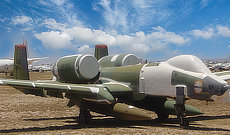
Davis-Monthan AMARG
As Air Force, Navy and Marine planes become obsolete and need to be disposed of, or saved for future return to service, they are stored in the largest airplane boneyard in the world, in the Arizona desert. The storage facility is operated by the 309th Aerospace Maintenance and Regeneration Group AMARG at Davis-Monthan Air Force Base in Tucson.
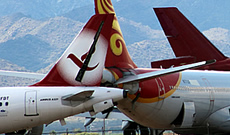

Airliner Boneyards
Jetliners eventually reach end-of-life due to airframe wear and/or obsolescence. Some jetliners are temporarily taken off flying status, and must be stored in a environment that is conducive to preservation. Others are kept for spare parts for flying aircraft, and eventually scrapped. Most of these airliner boneyards are located in Arizona and California.

Post-WWII Boneyards
Once peace was assured after WWII, the military found itself with a huge surplus of aircraft. Following the war, estimates of the number of excess surplus airplanes ran as high as 150,000. Consideration was given to storing a substantial number of airplanes, but the realization that the expense to store them was too great ... many needed to be sold or scrapped.

Visiting Boneyards
Virtually all airplane boneyards and storage facilities are limited access sites. Boneyards typically do not allow visitors and do not provide tours. We encourage potential visitors to check with individual sites to learn about access policies and tours, and avoid restricted areas.
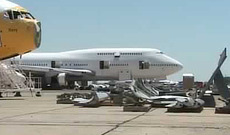
Reclamation & Scrapping
Commercial airliners have limited lifespans. Ultimately, they must be retired from service, stored in airplane boneyards or graveyards, and finally dismantled and scrapped.
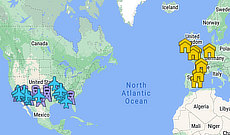
Boneyard Maps
A map is provided showing the commercial airliner boneyards in the U.S. and Europe as well as post-WWII boneyards.
Continued Evolution of This Aviation Website Series
We launched Planes of the Past in 2012, which over time grew into a large site covering a variety of aviation-related topics. In 2015, we split the website into more focused topics based on our viewers' interests. Now we offer the following websites which we welcome you to visit as we expand our content in 2024:
- Airplanes-Online - World War II, the Cold War and modern day airplanes
- AirplaneBoneyards.com - Military and airliner boneyards in the U.S., Europe & Australia (this website)
- AirlinerSpotter.com - Airliner spotting tips, Airbus and Boeing fleets with characteristics, comparisons and photographs
SITE MAP | PRIVACY POLICY | TERMS OF USE | CONTACT US
Copyright © 2024 AirplaneBoneyards.com All Rights Reserved. An online resource about facilities engaged in the storage, reclamation & disassembly of aircraft ... we do not own or operate a boneyard, or have an affiliation with any boneyard, the Department of Defense, or any aviation museum or tour group.

The Boneyard: A secret airplane graveyard in Tucson, Arizona
What happens to our nation's militarized aircraft when it's time to toss it? Welcome to the largest aircraft graveyard in the world, The Boneyard!
Watch the video above to see all of the cool planes and space aircraft!
The Boneyard is formally known as the 309th AMARG (Aerospace Maintenance And Regeneration Group). An AMARG is a boneyard facility for all excess military and government aircraft. Planes, jets, helicopters, and space shuttles belonging to the Air Force, Navy, Marine Corps, Coast Guard, and NASA are processed here. Another role of AMARG is to convert fighter jets into aerial target drones.
The 309th AMARG is located at the Davis-Monthan Air Force Base in Tucson, Arizona. This collection picked up steam after World War II. 550 people are currently employed to take care of the 4,400+ aircraft that call this airfield their permanent residence.
When the aircraft first arrive at the 309th AMARG, they are welcomed by the receiving branch. This group's responsibilities include reviewing the carrier's paperwork – an entire history of documentation including noted maintenance over the years. Next, the aircraft is stripped of firearms (all guns), ejection seat charges, clocks, and classified hardware. Following the cavity cleanse is a nice long bath. This wash is especially important for vehicles that served in salty areas. The salt must be fully removed so it does not corrode the exterior while in storage.
Sequentially, the fuel system is drained, filled with lightweight oil, then drained again. This will coat the system with a protective oil film. The aircraft is finally sealed off from dust, high temperatures, and sunlight. A variety of techniques are used, from spraylat (an opaque, white, high-tech vinyl plastic compound spray) to garbage bags. The cabin will generally stay within 15 degrees of the outside temperature thanks to the spraylat.
Finally, the aircraft is towed to its final resting place/designated storage position.
To visit the 309th AMARG, click here!
RELATED: Secrets of Arizona's Davis-Monthan Air Force Base!
ALSO: Secrets of Luke Air Force Base!
MORE: Secrets of Phoenix Sky Harbor Airport!
Report a typo
Sign up for the Headlines Newsletter and receive up to date information.
Now signed up to receive the headlines newsletter..

Record and watch live TV, subscription-free with Tablo

Odd News Show
Exploring America's Largest Aircraft Boneyard
Posted: March 4, 2024 | Last updated: March 4, 2024
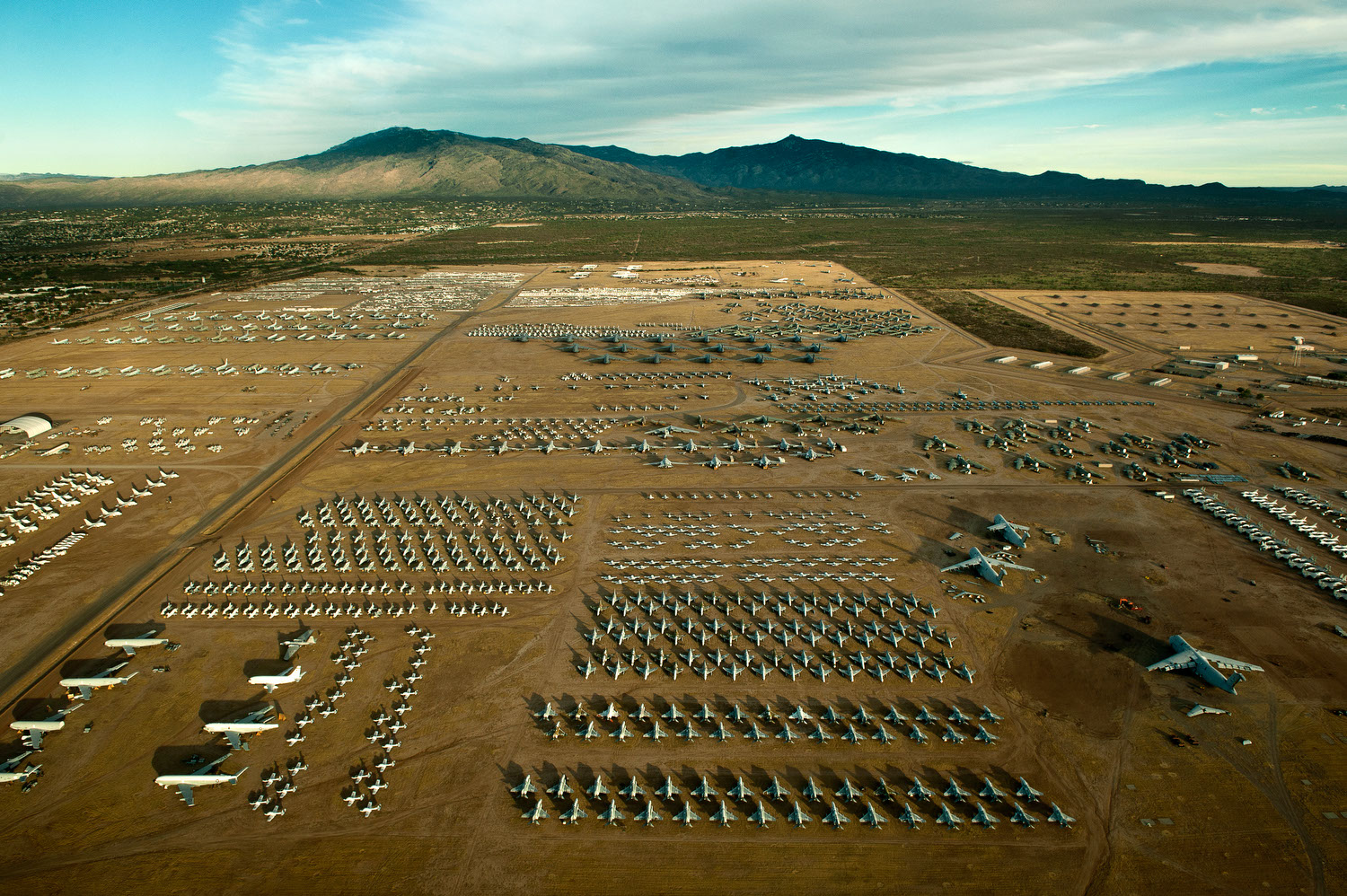
"Boneyard" at Davis-Monthan Air Force Base, Arizona
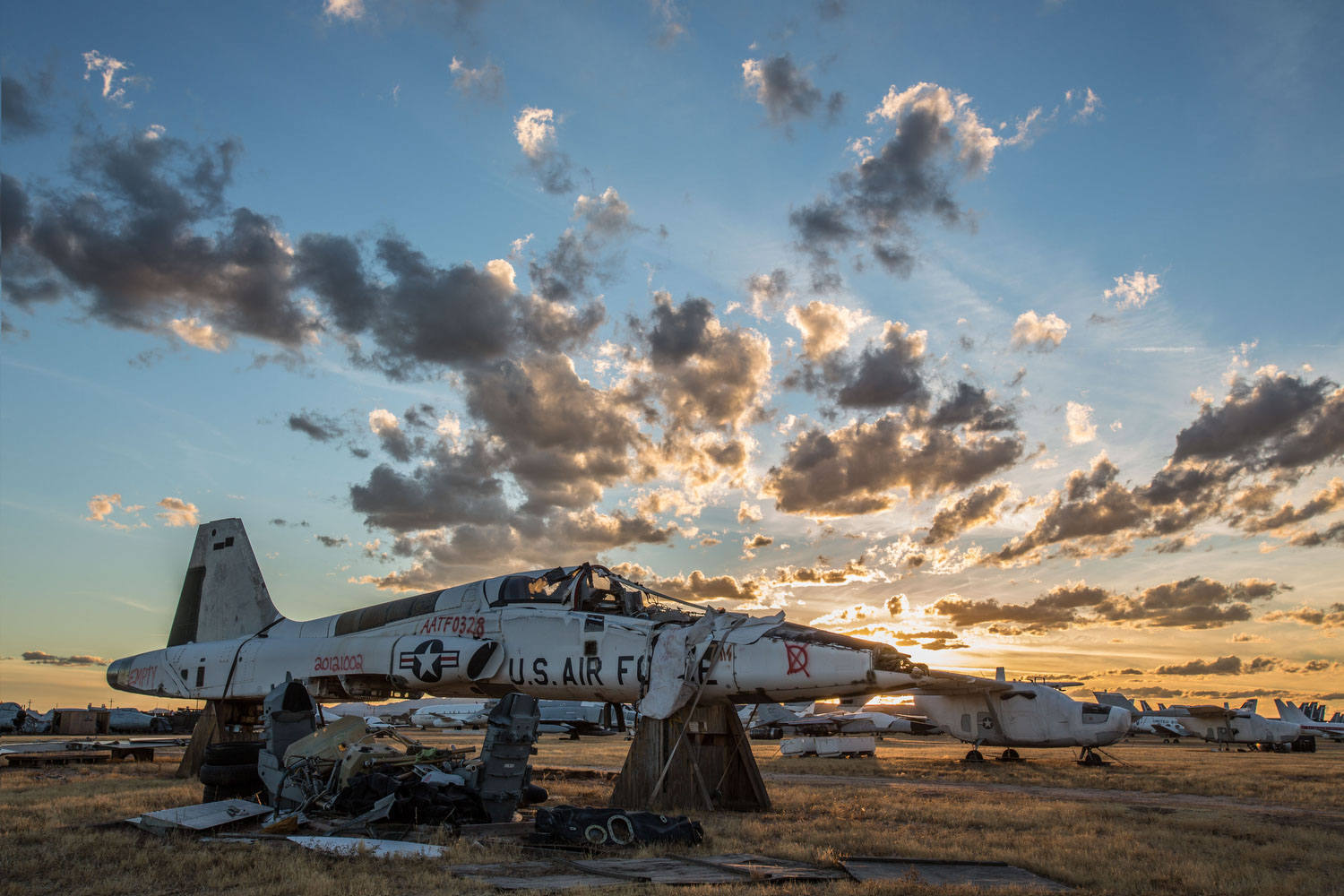
Retired T-38 Talon
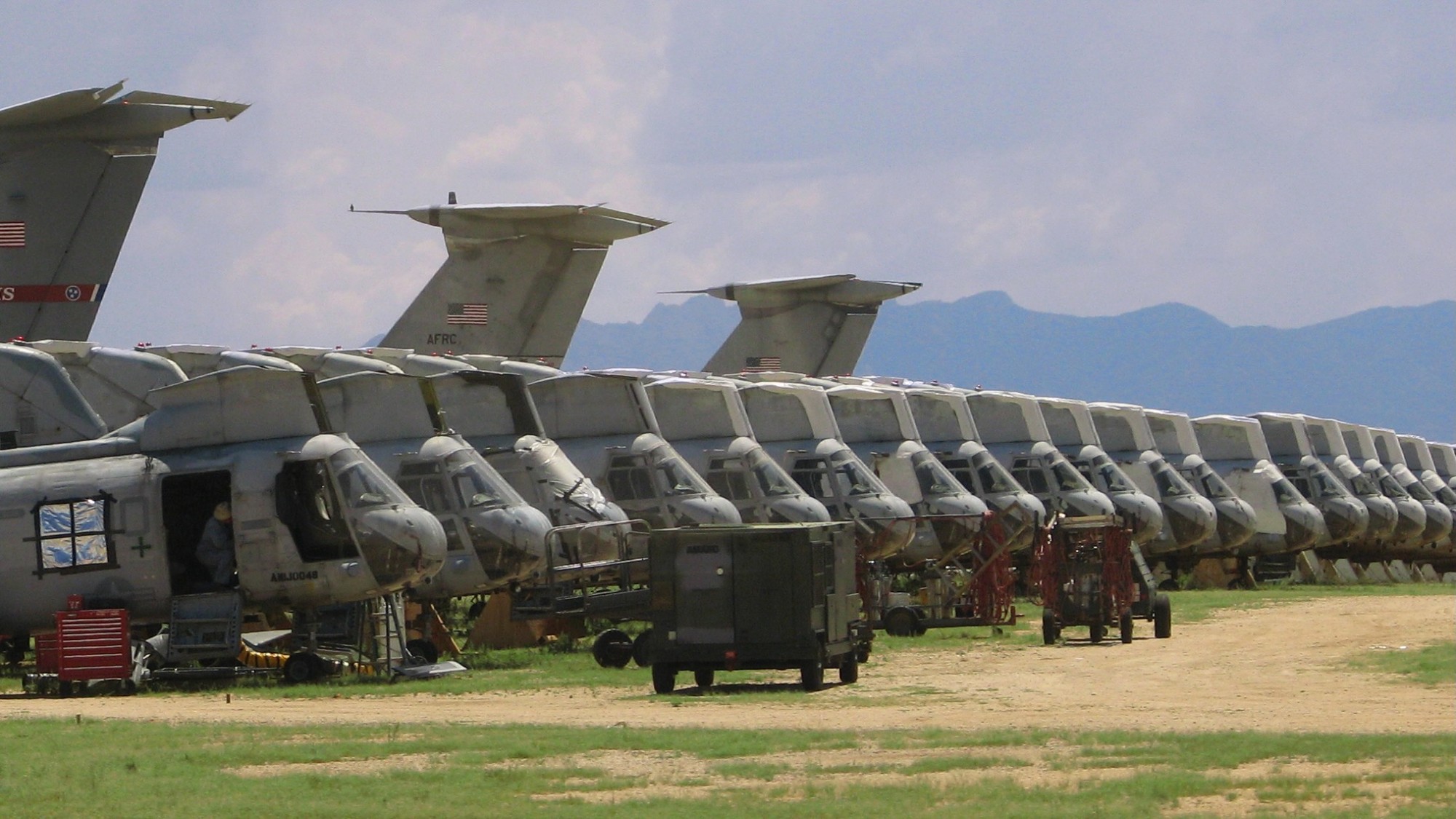
Marine CH-46 Sea Knight helicopters
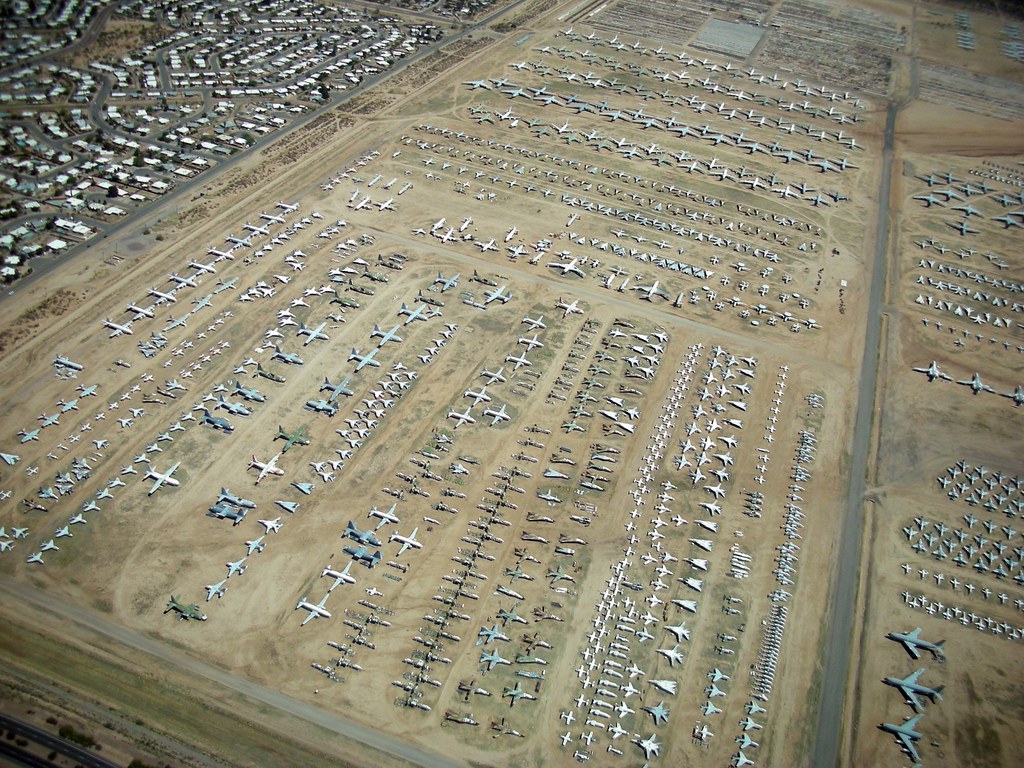
Rows and Rows of Retired Planes

D-21 Supersonic Spy Drone
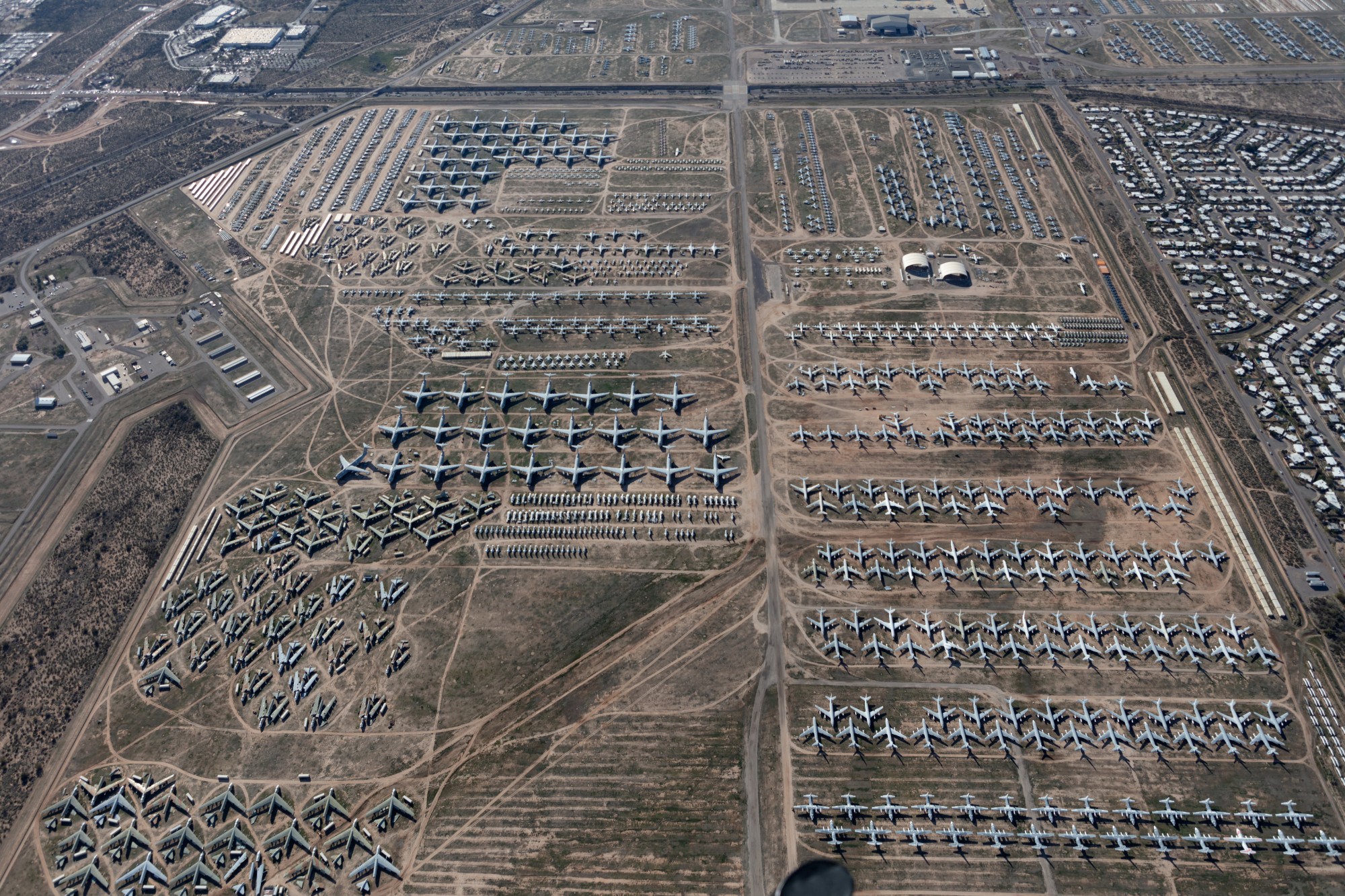
The Vastness of Davis-Monthan Air Force Base
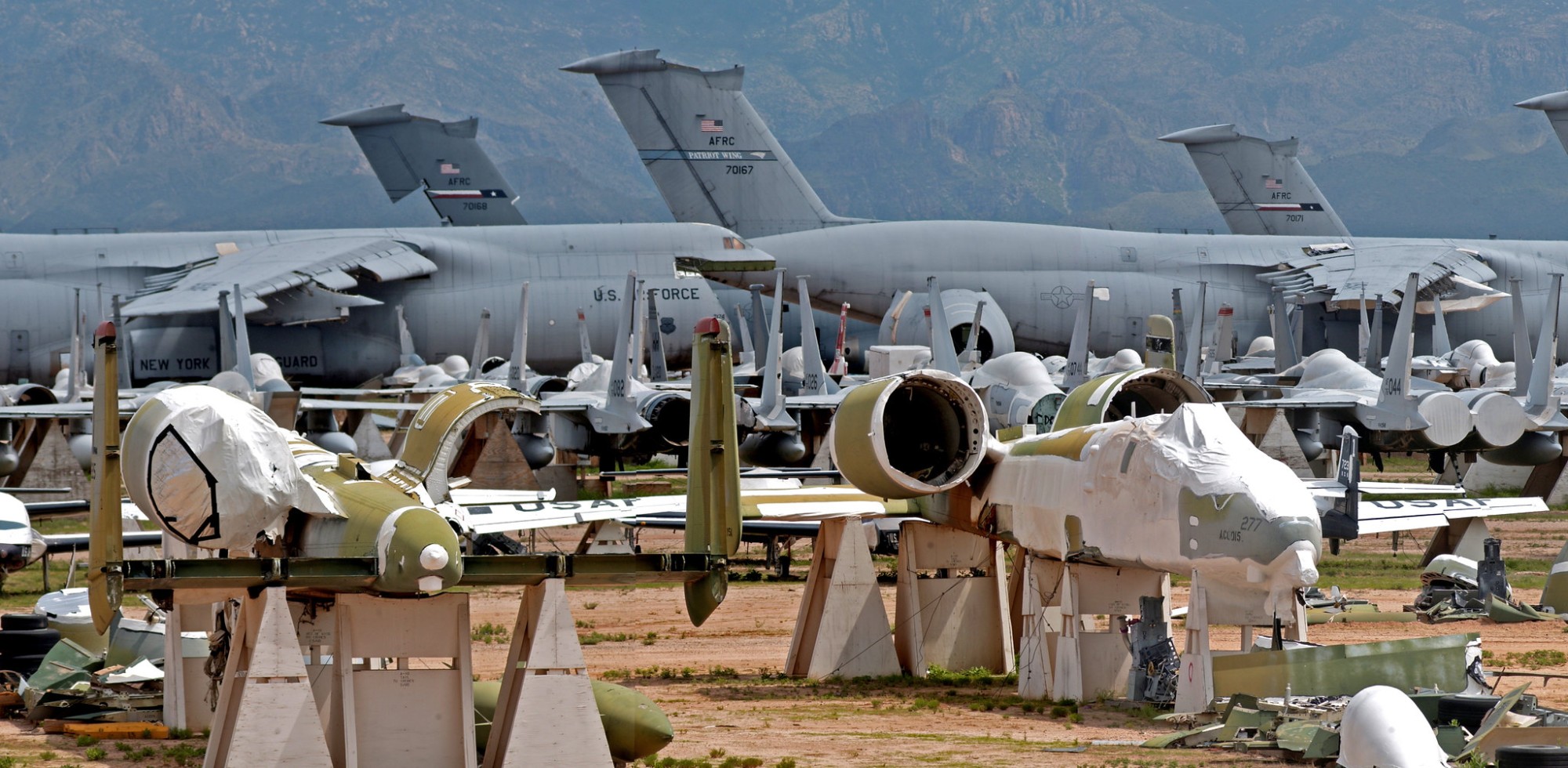
A-10 thunderbolts, F-15 Eagles, and C-5 Galaxies
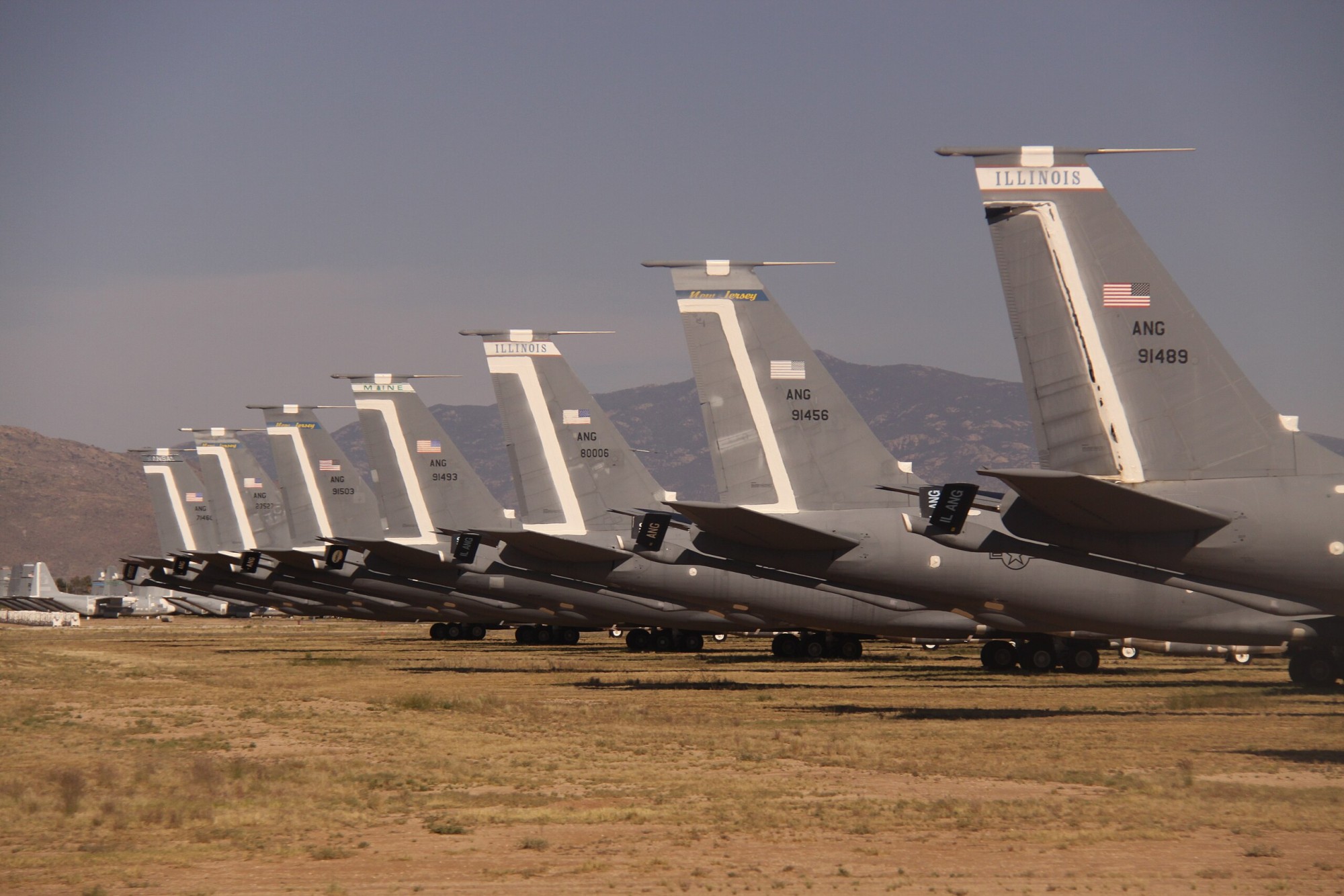
Boeing KC-135
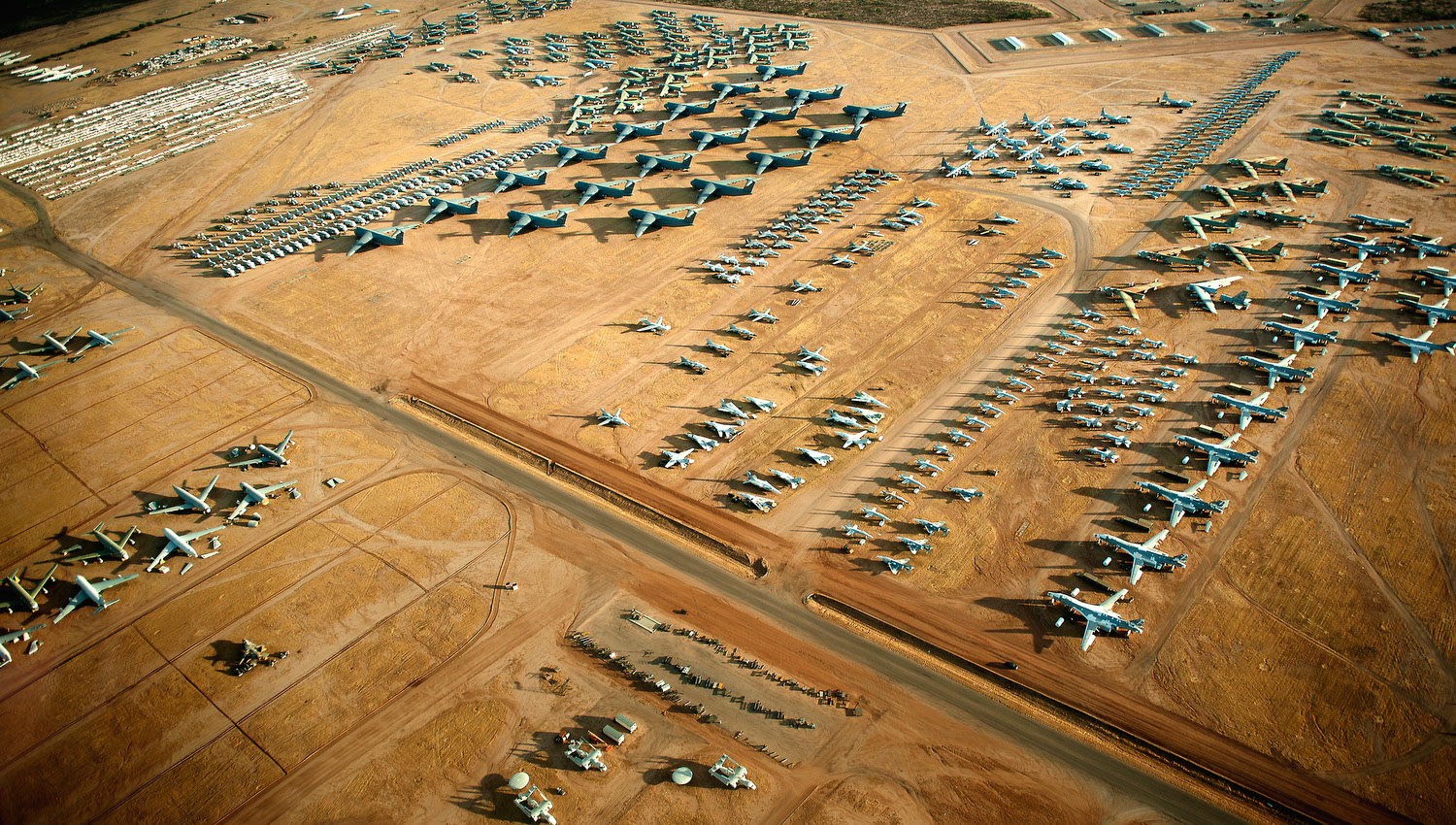
The Beauty of the Boneyard
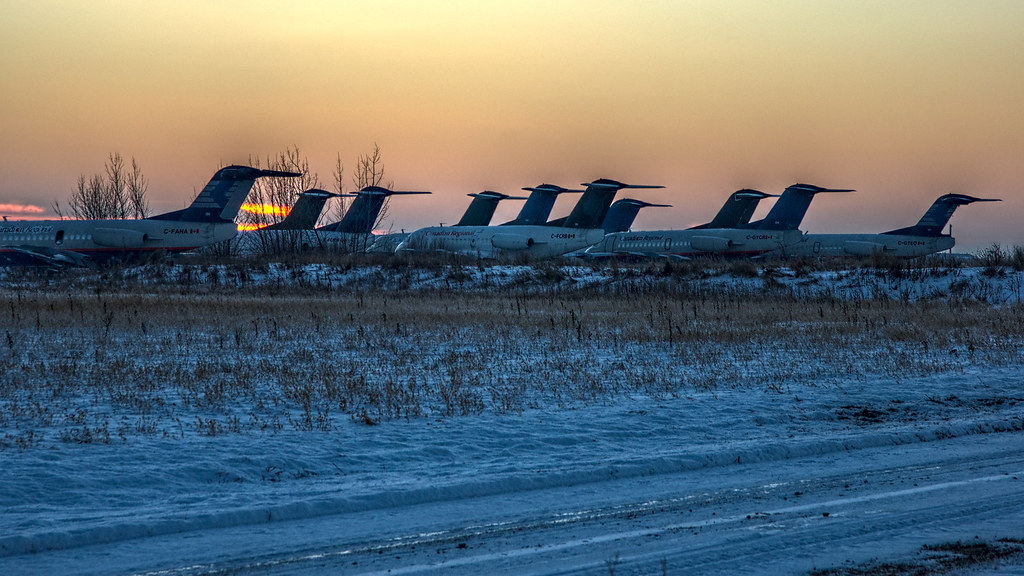
Sun Setting on the Boneyard
More for you.
Megan Fox Signs With UTA
'We will call him President Trump’: Defense lawyers vacillate between honorifics
Here's No. 1 thing mentally strong couples 'never' do, says relationship therapist of 20 years
Buying and selling a home will change soon. Here’s what you need to know.
Jason Kelce shares update about his ‘stolen’ Super Bowl ring
6 Money Moves To Make When Your 401(k) Hits $1 Million
A woman said her tattoos got her rejected for a job, but experts say personality is far more important
The best 'Star Trek' episode of all time, according to fans—and see if your favorite ranks in the top 25
What a Final Fantasy 7 Rebirth: Intergrade DLC Could Cover
Arsenal kit 2024-25: Why Gunners are replacing club crest with cannon
14 Things You Should Never Divulge to Anyone Else About Yourself
Here’s What the US Minimum Wage Was the Year You Were Born
Owen Wilson turned down ‘$12m offer’ to star in movie depicting OJ Simpson as innocent
The best Western show in TV history isn't 'Gunsmoke' or 'Bonanza,' according to data. Check out the top 50.
Alexandria Ocasio-Cortez Rips Democrat's 'Shameful' Post on Bernie Sanders
NFL Draft: Top 25 No. 1 Picks in History
21 of the absolute best fictional princesses
I’m a Bank Teller: 3 Times You Should Never Ask For $100 Bills at the Bank
If you and your partner use any of these 5 phrases regularly, your relationship is stronger than most
Strawberry-Rhubarb Breakfast Cake Will Make Everyone Spring Out Of Bed

70+ years of the boneyard at Davis-Monthan Air Force Base
- Nov 8, 2019
- Nov 8, 2019 Updated Oct 12, 2020
- Copy article link
Plenty of planes have gone through the Boneyard since it opened in the mid-1940s. Here are photos of some of them.
Read more about the boneyard >> http://tucne.ws/1ckp
Did you know? The Star has a throwback email newsletter! We send snapshots of Tucson history to your inbox every Thursday. Sign up >> tucson.com/timemachine
D-M Air Force Base Boneyard history
Boeing B-29 bombers of the 19th Bomb Wing arrive at Davis-Monthan AFB, Tucson, during a ceremony marking their retirement from service in 1954 and subsequent storage at the Boneyard. Tucson Citizen file
Boneyard at Davis-Monthan Air Force Base
"Bockscar," the Boeing B-29 bomber that dropped the atomic bomb on Nagasaki, Japan, in 1945, shown in storage at Davis-Monthan AFB, Tucson, in 1955. It was transferred to the National Museum of the U.S. Air Force in 1961.
The Boneyard at D-M AFB
Propellers from doomed B-36 bombers in front of the giant planes at the Davis-Monthan storage yard in 1958. The planes were being scrapped. Each yielded 43,000 pounds of aluminum.
The first two Navy aircraft to be transferred to the Boneyard at D-M from Litchfield Park near Phoenix for storage arrive Jan. 13, 1965. The planes, F9F Cougars, were the first of several hundred that were brought to Tucson as the Litchfield Navy storage facility was phased out. The 2704th Aircraft Storage and Disposition Group became the storage center for obsolete Navy, Marine and Coast Guard aircraft as well as Air Force planes. Photo by Art Grasberger / Tucson Citizen / Jan. 13, 1965
Crew stand in front of a Convair B-58 Hustler supersonic bomber slated to be removed from active service at Davis-Monthan Air Force Base in 1969.
A Royal Air Force Vulcan bomber waiting to be mothballed at Davis-Monthan AFB in 1970.
The first Boeing 707, a prototype airplane designated the 367-80, was restored for flight by Boeing workers at Davis-Monthan Air Force Base after being "mothballed" in Tucson for 18 years. The plane as being flown to Moses Lake near Seattle before it found a home with the Smithsonian annex at Dulles International Airport. Photo by Bruce McClelland / Arizona Daily Star / 1990
Neg~58820; Davis-Monthan Boneyard---Rows of B-52’s sit on the hard desert soil in Tucson, Arizona. The dry air and hard soil are the two main reasons the “Boneyard” is located here. The dryness preserves the airframes and the hard soil prevents the heavy planes from sinking into the ground. Arizona Daily Star file photo from 1991. Copyright 1996 The Arizona Daily Star Organization:Davis Monthan Air Force Base/Aircraft; Identity:Boneyard; PLS:Aircraft; AMARC
Davis-Monthan AFB history
B-52 bombers in the "boneyard" or Aerospace Maintenance & Regeneration Group at Davis-Monthan AFB in 1998. The B-52 at the right has been dismantled. David Sanders / Arizona Daily Star
A USAF EC-135 (Boeing 707), Looking Glass, sits on the runway at Davis-Monthan Air Force Base on Friday, Jan. 16, 1998, after it's last flight before being retired to the boneyard. (AP Photo/John Miller)
Parked US Navy Hurricane planes sit idle in DMAFB's "boneyard" where hundreds of military planes are stored. Photo by David Sanders / The Arizona Daily Star / Nov. 23, 1998
A-7's sit at the Aerospace Maintenance and Regeneration Center. The A-7 is an attack aircraft that was used in Vietnam. Xavier Gallegos / Tucson Citizen / 1999
This Navy LC-130F cargo plane was renamed Phoenix by the crew that last flew it after it was recovered then repaired at the AMARC section of the Davis-Monthan Air Force Base on April 24, 2002. It crashed in 1971 and was buried in the snows of the Antarctic for 17 years. Photo by A.E. Araiza/Arizona Daily Star/2002
For the first time since1960, Don Angier of Tucson returns to the cockpit of this Navy LC-130F cargo plane on April 24, 2002, which he piloted along with others in his squadron from 1959-1960. The Davis-Monthan AMARC/boneyard repaired the plane after it crashed on December 4,1971,during a JATO take-off to return to McMurdo Sound. At an altitude of about 50 feet, two JATO bottles separated from the left-hand side of the fuselage and struck the inboard engine and propeller and was buried in the snows of the Antarctic for 17 years. Photo by A.E. Araiza.
This Navy LC-130F cargo plane was recovered and repaired at the Davis-Monthan AMARC/boneyard after it crashed in 1971 and was buried in the snows of the Antarctic for 17 years on Wednesday, April 24, 2002. It was put back into service at the Point Mugu Naval Weapons Test Center. The plane was used in Operation Deep Freeze, a joint U.S. military operation that supported the National Science Foundation's activities in Antarctica. Photo by A.E. Araiza/Arizona Daily Star/2002
Don Angier of Tucson looks one last time towards the flight deck of a Navy LC-130F cargo plane on April 24, 2002, which he piloted along with others in his squadron from 1959-1960. The Davis-Monthan AMARC/boneyard repaired the plane after it crashed in 1971 and was buried in the snows of the Antarctic for 17 years. Photo by A.E. Araiza/Arizona Daily Star
A shot of the bone-yard area at DM where the A-10 Warthogs were stored on June 6, 2003. Photo by Benjie Sanders/ Arizona Daily Star
Terry Stafford, an aircraft mechanic who works for Lockheed and Martin, is working on a A-10 in the AMARC area of the airbase in a program called Hog Up, which does maintenance on these planes to try to keep them going. Photo by Benjie Sanders / Arizona Daily Star June 6, 2003
Petronilo Alvarado, an AMARC aircraft mechanic, is working on a A-10 in the AMARC area of the airbase in a program called Hog Up, which does maintenance on these planes to try to keep them going. Photo by Benjie Sanders / Arizona Daily Star/ June 6, 2003
A Tennessee Air Guard C-141B is a good buy according to those that flew her last flight to AMARC. The preservation team checks on each of the aircraft every 120 days in the level 1000 storage area, the highest maintained area, where planes can be ready in a matter of days if need be. Photo by David Sanders/Arizona Daily Star / Nov. 2, 2004
Sal West uses black plastic tape to seal the cockpit windows of a Navy P-3 at (AMARC), before they get sprayed with spraylat. Sal says of AMARC's ability to ready these planes for flight, "Although some of these look like they are sitting here dead, in a couple of days they are ready to roll." Photo by David Sanders / Arizona Daily Star / 2004
Navy P-3 (A and C models) sit in storage at AMARC, also known as the "boneyard." Tucson's low rainfall, low humidity, and alkaline soil make it an ideal storage area for over 4,400 aircraft from the Air Force, Army, Navy, Marine Corps, and Coast Guard. Photo by David Sanders/Arizona Daily Star / Nov. 2, 2004
05/20/2004. S7; EAST SIDE TODAY; F-16 Fighting Falcons (above and top) are among the more than 4,300 aircraft at AMARC. A row of F-16 Fighting Falcons sit Thursday afternoon at the Airspace Maintenance and Regeneration Center (AMARC). The 2,600-acre facility, adjacent to the David-Monthan Air Force Base, currently is home to more than 4,300 aircraft. The acquisiton cost of those aircraft is about $31 billion, which is the cost of the aircraft when they were built. 05/20/2004. S7; EAST SIDE TODAY; A group of F-16 Fighting Falcons sit Thursday afternoon at the Airspace Maintenance and Regeneration Center (AMARC). The 2,600-acre facility, adjacent to the David-Monthan Air Force Base, currently is home to more than 4,300 aircraft. The acquisiton cost of those aircraft is about $31 billion, which is the cost of the aircraft when they were built. 05/20/2004. S9; EAST SIDE TODAY; Aircraft mechanic Mark Gonterman works on the wings from an A-10 Thunderbolt II at AMARC's reclamation shelter. Aircraft mechanic Mark Gonterman (CQed) works on the wings from an A-10 Thunderbolt II (also known as the Warthog) Thursday afternoon while at the reclamation shelter at the Airspace Maintenance and Regeneration Center (AMARC). The 2,600-acre facility, adjacent to the David-Monthan Air Force Base, currently is home to more than 4,300 aircraft. The acquisiton cost of those aircraft is about $31 billion, which is the cost of the aircraft when they were built.
Retired airplanes at AMARC. This image was taken April 25, 2005, from Google's satellite image feature at maps.google.com . Image courtesy of Google Maps.
Titan missiles at AMARC await the shredder. Titan Missile Museum archives. Photo by Chuck Penson, courtesy of Arizona Aerospace Foundation 2006.
Photographer Pam Reed photographs retired pilot and former POW Bob Barnett (BOB BARNETT) at the Aerospace Maintenance and Regeneration Center (AMARC, aka the Boneyard), next to a T-33 trainer jet, one of the many kinds of planes Barnett flew during his service. Photo by Chris Richards, Arizona Daily Star/March 14/ 2007
Contractors continue work on the Aircraft Maintenance and Regeneration Group's newest aircraft maintenance hangar on Monday, Oct. 28, 2013, on Davis-Monthan Air Force Base in Tucson, Ariz. The hangar, expected to be completed by February of next year, will be wide enough to house two C-130 aircraft, and tall enough to accommodate the airframe of a KC-135. Photo by Mike Christy / Arizona Daily Star
A KC-135 aircraft sits outside the Aircraft Maintenance and Regeneration Group's aircraft maintenance hangar on Oct. 28, 2013, as the hanger is being built at Davis-Monthan Air Force Base. The hangar is wide enough to house two C-130 aircraft, and tall enough to accommodate the airframe of a KC-135. Photo by Mike Christy / Arizona Daily Star
Steve Dennett, left, and Fred Vega with the 577th CRMS or Commodities and Reclamation Squadron have a crane lift the tail section of the last B-52G Stratofortress under the New START Treaty is disassembled at the 309th Aerospace Maintenance and Regeneration Group at Davis-Monthan Air Force Base. A surgical cut to the fuselage of aircraft 58-0224 separated the tail section from the rest of the plane which satisfies the requirements of the treaty for the elimination of heavy bombers. The demolition is the last of 39 B-52G's destroyed in order to be in compliance with the New START Treaty. Confirmation of its destruction will be checked by satellite. During the aircraft's lifetime it flew numerous missions over North Vietnam in December 1972 in support of Operation Linebacker II. Specifically, the bomber flew missions that targeted the Hanoi and later the Yen Vien (YEN VIEN) railroad yards. After many years of service the ship was retired to the 309th AMARG, otherwise known as the boneyard at DM in February 1990. The photo was taken on Thursday, December 19, 2013 in Tucson, Ariz. Photo by A.E. Araiza/ Arizona Daily Star
This is the last B-52G Stratofortress, number 58-0224, under the New START Treaty that was disassembled at the 309th Aerospace Maintenance and Regeneration Group at Davis-Monthan Air Force Base. A surgical cut to the fuselage of aircraft 58-0224 separated the tail section from the rest of the plane which satisfies the requirements of the treaty for the elimination of heavy bombers. The demolition is the last of 39 B-52G's destroyed in order to be in compliance with the New START Treaty. During the aircraft's lifetime it flew numerous missions over North Vietnam in December 1972 in support of Operation Linebacker II. Specifically, the bomber flew missions that targeted the Hanoi and later the Yen Vien railroad yards. After many years of service the ship was retired to the 309th AMARG, otherwise known as the boneyard at DM in February 1990. Photo by A.E. Araiza/ Arizona Daily Star / Dec. 19, 2013
Two runners hustle across a field for the start of the first Desert Boneyard 5K Fun Run/Walk on April 27, 2013, at the 309th Aerospace Maintenance and Regeneration Group's aircraft storage facility on Davis-Monthan Air Force Base. The 309th AMARG provides depot-level maintenance, aircraft regeneration, storage and preservation, aircraft parts reclamation and disposal in support of the U.S. Department of Defense, allied war-fighters and other government agencies. Photo by Mike Christy / Arizona Daily Star
A converted F-16 is being evaluated by John Lathrop after it flew the day before at Davis-Monthan Air Force Base. The QF-16 program, taking place at the Air Force's 309th Aerospace Maintenance and Regeneration Group, is tasked with taking part in converting the F-16 into a full-scale aerial target or drone. AMARG maintains and refits military aircraft and is also a storage facility. Photo by A.E. Araiza/ Arizona Daily Star/ April 3, 2014
A-10 Warthogs are lined up at the Air Force's 309th Aerospace Maintenance and Regeneration Group, or AMARG, which maintains and refits military aircraft and is also a storage facility. The region's low humidity, hard soil and low rainfall, which reduces rust and corrosion, makes the location ideal. Photo by A.E. Araiza/ Arizona Daily Star / April 3, 2014
Rodney Vakoc, left, and Rick Lee, with the 577th CRMS or Commodities and Reclamation Squadron pull on the tail section separating it from the last B-52G Stratofortress under the New START Treaty as it was disassembled at the 309th Aerospace Maintenance and Regeneration Group at Davis-Monthan Air Force Base. Photo by A.E. Araiza / Arizona Daily Star / Dec. 19, 2013
Retired B-52 pilot, Gen. Earl O'Loughlin, left, trades stories with AMARG commander Col. Robert S. Lepper after the last B-52G Stratofortress under the New START Treaty is disassembled at the 309th Aerospace Maintenance and Regeneration Group at Davis-Monthan Air Force Base. O'Loughlin, among many assignments during his career with the air force, served as a B-52 aircraft commander and instructor pilot with the 379th Bombardment Wing at Wurtsmith Air Force Base, Mich. A surgical cut to the fuselage of aircraft 58-0224 separated the tail section from the rest of the plane which satisfies the requirements of the treaty for the elimination of heavy bombers. The demolition is the last of 39 B-52G's destroyed in order to be in compliance with the New START Treaty. Photo by A.E. Araiza/ Arizona Daily Star/ Dec. 19, 2013
16 boneyard dsp11--There are many aspects in addition to the preservation team at the Aerospace Maintenance and Regeneration Center (AMARC), like Joe Kelly (cq-Joe Kelly) who has worked for 22 years at the sheet metal shop and is currently preparing an F-4 backseat canopy for use, using a micro mesh sandpaper to rough out a nick. The 2,600 acre plot on the DMAFB is home to over 4,400 military aircraft. Photo by David Sanders/Arizona Daily Star. Mandatory credit: no mags, no sales. #119057.
An AMARG aircraft electrician works in the cockpit of an F-16 being retrofitted as a target drone at the The 309th Aerospace Maintenance and Regeneration Group (309 AMARG) hanger at Davis-Monthan Air Force Base. Photo by Ron Medvescek / Arizona Daily Star.
Electricians Demetrius Moore, lower right, and William McNew install a new oxygen unit in an A-10 at the 309th Aerospace Maintenance and Regeneration Group (309 AMARG) at Davis-Monthan Air Force Base. Photo by Ron Medvescek / Arizona Daily Star.
Tony Hernandez, an employee of Affordable Engineering Service tapes off unneeded connectors on an F-16 at the 309th Aerospace Maintenance and Regeneration Group (309 AMARG) at Davis-Monthan Air Force Base. Photo by Ron Medvescek / Arizona Daily Star.
An A-10 sits in a stall at the 309th Aerospace Maintenance and Regeneration Group (309 AMARG) at Davis-Monthan Air Force Base . It is part of the SLEP (Service Life Extension Program) extending service life of the planes to 2028. Photo by Ron Medvescek / Arizona Daily Star.
B-52 bombers at AMARC. At right and left are intact bombers. In the center are bombers that have been dismantled. This image is taken from Google's new satellite image feature at maps.google.com . Image courtesy of Google Maps.
An Alenia C-27J Spartan aircraft in the cover of shade at the 309th Aerospace Maintenance and Regeneration Group (309 AMARG) at Davis-Monthan Air Force Base. Photo by Ron Medvescek / Arizona Daily Star.
A Radar array sits inside the nosecone of an F-16 being retrofitted as a target drone at the 309th Aerospace Maintenance and Regeneration Group (309 AMARG) at Davis-Monthan Air Force Base. Photo by Ron Medvescek / Arizona Daily Star.
An A-10 flies over the 309th Aerospace Maintenance and Regeneration Group (309 AMARG) storage facility above a retired A-10 at Davis-Monthan Air Force Base. Photo by Ron Medvescek / Arizona Daily Star/ April 25, 2015
AMARG's Aircraft work leader Steve Herman, left, and Matt Vandervort of Affordable Engineering Service work together to change a nose shock strut on the landing gear of an F-16 being renovated at the 309th Aerospace Maintenance and Regeneration Group (309 AMARG) at Davis-Monthan Air Force Base. Photo by Ron Medvescek / Arizona Daily Star / April 25, 2015
Electricians Demetrius Moore, lower left, and William McNew exchange parts during installation of a new oxygen unit in an A-10 at the 309th Aerospace Maintenance and Regeneration Group (309 AMARG) at Davis-Monthan. Photo by Ron Medvescek / Arizona Daily Star / 2015
Workers beneath an F-16, retrofitting it as a target drone at the 309th Aerospace Maintenance and Regeneration Group (309 AMARG) at Davis-Monthan Air Force Base. Photo by Ron Medvescek / Arizona Daily Star/ April 25, 2015
F-16s are being retrofitted as target drones at the 309th Aerospace Maintenance and Regeneration Group (309 AMARG) hanger at Davis-Monthan Air Force Base. Photo by Ron Medvescek / Arizona Daily Star / April 25, 2015
An A-10 sits in storage with The Catalina Mountains in the background at the 309th Aerospace Maintenance and Regeneration Group (309 AMARG) storage facility at Davis-Monthan Air Force Base. Photo by Ron Medvescek / Arizona Daily Star / March 20, 2015
Noses of retired A-10s at the 309th Aerospace Maintenance and Regeneration Group (309 AMARG) at Davis-Monthan Air Force Base. Photo by Ron Medvescek / Arizona Daily Star / 2015.
- Retrotucson
As featured on
Aircraft 'boneyard' marks 70th year in tucson.
The 309th Aerospace Maintenance and Regeneration Group was set up in 1946 to store surplus World War II aircraft.
Davis-Monthan saluted ahead of Veterans Day
Schools and businesses decorated and Tucson's mayor proclaimed D-M “Americas Asset and Tucson’s Treasure.”
Boeing eyes Southern Arizona site for space-capsule landings
Aero giant plans to land Starliner space capsules on a dry lakebed near Willcox, possibly as soon as mid-December.

View this profile on Instagram #ThisIsTucson 🌵 (@ this_is_tucson ) • Instagram photos and videos
Most viewed stories
50 fun events happening in tucson this weekend april 18-21 🎡, a giant list of restaurant patios in tucson: brunch, fine dining and more, 11 local farmers markets to check out in and around tucson 🥬, this local food truck is bringing a taste of oaxaca to tucson, sweet tomatoes in tucson is finally here 🎉 ... and it's the only location in the whole country, ranking the craziest foods at this year's pima county fair 🍨, this historic tucson home is now a tiny hotel and art gallery 🏠, the man behind borderlands is opening a new agave-based hotspot, this tucson organization is celebrating 50 years of women in the arts 🎨, 48 free events happening in tucson this april 2024 💸.
See one of the world's biggest aircraft 'graveyards' where planes go to die — and airlines can dissect them for parts
- Pinal Air Park in Arizona is one of the largest aircraft storage facilities in the world.
- The multi-million business boomed during the pandemic as airlines worldwide grounded hundreds of jets.
- The airpark is also a hub for maintenance, as well as re-configuring jets when they get a new operator.
As the aviation industry hopes to reduce its carbon footprint, companies are coming up with new strategies to alleviate CO2 emissions.
in April, the Aviation Circularity Consortium, including Australian flag carrier Qantas and other groups, was created as a "joint mission to accelerate supply chain decarbonisation."
The plan is to use the 8,000 "end-of-life retired aircraft" that are sitting in deserts, jungles, and storage yards across the globe. Another 11,000 are expected to be available over the next 10 years.
According to the consortium, the thousands of decommissioned aircraft offer "a new source of valuable circular materials" and address the "significant waste pollution challenges to the shrinking legal boneyards around the world."
These "graveyards" started filling up during the pandemic when airlines had to make drastic cost-cutting changes, including furloughing pilots, cutting routes, and indefinitely storing hundreds of planes in the desert.
One of these facilities is Pinal Air Park in Marana, Arizona — a small town located about 90 miles southeast of Phoenix.
As airlines started to shrink in 2020, hundreds of planes from all over the world flew to the 2,080-acre airpark.
With the influx, Pinal had to take special precautions to ensure the aircraft was ready to fly once travel eventually rebounded.
Because of this, Ascent Aviation Services — the largest aircraft service provider on the airfield — had to beef up its staff to maintain the constant arrivals.
Company CCO Scott Butler told Business Insider last year that starting in March 2020, planes were coming in at about one per hour — requiring over 150 extra mechanics.
Additional parking lots were built to handle the hundreds of planes, which continued to be filled into 2021 and 2022 with jets coming from places like the US, South Korea, UK, Australia, and Canada.
I went inside one of the US' largest aircraft storage facilities and saw how it isn't emptying out despite the rise in air travel
Leasing companies were also filling the airfield after buying up inexpensive planes sold during COVID and storing them at Pinal.
Inside a remote Arizona aircraft boneyard storing nearly 300 planes grounded by the pandemic
However, with travel now roaring back and demand on track to surpass 2019 levels, AAS has gotten back to its roots — maintenance, repair, and overhaul (MRO).
Basic offerings include simple maintenance checks and on-demand repairs, like fixing the landing gear or inspecting the flight controls.
However, heavy maintenance is the most costly for airlines. This involves a full assessment of the aircraft and can take up to 60 days for widebody jets, Butler explained.
"A narrowbody will cost around $2 million," he told BI in May 2023. "With widebodies, you're easily looking at $3 million."
These projects take a lot of manpower. Butler said the company targets 400-500 hours per day for widebodies and 300 per day for narrowbodies.
Because the checks are so expensive, many carriers opt to sell the aircraft when it gets to that stage in its lifecycle, which is typically every six to 10 years.
Source: National Aviation Academy
Or, the operator will allow an aircraft lease to expire. This means if the lessor finds a new home for the plane, it will need to be fitted for its next contract.
For these conversions, AAS offers additional services, like re-painting liveries, switching out flight systems, and installing new cabins.
Sometimes, aircraft will transition from a passenger jet to a cargo plane — a service the company saw increased popularity during the pandemic, especially with older jets.
See the giant Airbus A330 freighter aircraft that will power a new lucrative cargo operation for Amazon
For flight tests and deliveries, the operator will arrange pilots, who will land and depart on the designated runway stretching Pinal's airfield.
Overall, Butler said AAS can do nearly anything an airline would need from an MRO standpoint.
The main service it can't provide is engine overhauls, which are outsourced to other shops.
"A lot of our current projects are just waiting on engines," Butler told BI. "There's a backlog because no one did engine maintenance during COVID because of the expenses."
He explained this is adding to the already strained supply chain that has caused a slowdown in returning aircraft to service.
While AAS does a lot of work keeping airplanes flying, it also offers aircraft reclamation and end-of-life services — what the consortium wants to capitalize on.
This involves disassembling and disposing of unwanted parts, which make up about 10% of the airplane.
According to Butler, the other 90% is recyclable. These include things like engines and galley carts...
...and avionics and landing gear.
However, he said custom interiors do not have much value except to the original operator.
A plane can spend months being salvaged, with hundreds of collected parts being resold or repaired for future use.
The re-certified pieces can be sent back to airlines who keep them in their inventory as spare parts — meaning retired jets can still provide for current ones.
Meanwhile, some carriers will take parts of the metal to create memorabilia, like cutting the logo or airline name from the fuselage and using it as wall art.
In addition to the strong MRO and reclamation divisions, storage and parking is still a strong revenue source for AAS.
"80% of all the stored aircraft worldwide are stored in the Southwest," Butler told BI in 2021.
During an April 2023 tour of the airpark, BI found the main lot full of planes, including two rare Boeing 747SPs.
Mechanics spend up to two weeks getting a plane ready for storage. Important components like the engines, pitot tubes, systems, and landing gear are sealed and protected.
This is especially important to prevent critters and other wildlife from taking up residence in the airplane's openings and small crevices.
Butler told BI the stored aircraft also get regular maintenance checks to keep them airworthy.
Parked planes, on the other hand, do not get this service and can be left to collect dust — giving Pinal its "boneyard" nickname.
- Main content

IMAGES
COMMENTS
Last Updated on September 8, 2022 . I could stare at airplanes for hours. Which is exactly what I did at the Tucson Boneyard (geek-heaven!) The Tucson airplane graveyard is a must-visit site for anyone who loves aircraft (that's us!).Learn about this amazing place, and how you can visit "the Boneyard," as it's unofficially known.
Due to changes in U.S. Air Force security considerations, the offsite bus tours of the 309th AMARG (AKA "The Boneyard") are no longer available, with no plans to restart. However, the Pima Air & Space Museum will provide an opportunity to learn about the history of AMARG and have a very similar experience viewing rare aircraft outdoors in a desert climate while immersing yourself in ...
It is a US Air Force base 5 miles southeast of downtown Tucson, Arizona, and is famous for its massive aircraft boneyard for storing American military aircraft. The Davis-Monthan Air Force Base is the destination for all American excess military and aerospace craft. Tuscon is an interesting city, and there is plenty to keep one busy if coming ...
Boneyard Safari is located at 10645 N Oracle Road, Suite 121 - 101, Oro Valley, Arizona 85737. Phone 520.314.7478. For more information: Aircraft Restoration & Marketing (ARM) Boneyard Safari. Tours offer walk through aircraft, history at Tucson "boneyard" Arizona Daily Star - Tucson.com - 04/20/2017
Price: $ 350 per group plus admission to the museum per person. Duration: 45 minutes non-stop. Reservations: must be made a minimum of two weeks in advance using our online booking system. Capacity : a max of 35 participants per tram. If your group has more then 35 participants and are arriving on a bus, we can accommodate the tram tour using ...
Tours offer walk through aircraft, history at Tucson "boneyard" Arizona Daily Star - Tucson.com - 04/20/2017: Air Force's oldest HC-130 retires from Patrick AFB in Florida Florida Today - 03/07/2017: More older model C-130s being sent to AMARG Montgomery Advertiser - Alabama - 01/12/2017
The next Boneyard Safari tour through the aircraft at Aircraft Restoration & Marketing, 5080 E. Nebraska St., is May 6. It will start about 7 a.m. and take 2½ to 3 hours. The tour is $25. More ...
Pima Air and Space Museum - Practical Information. Take exit 267, Valencia Rd, off I-10 and follow the brown signs to Pima Air and Space Museum. Sign up for the boneyard tour immediately after arrival, as seats are first come first served. Plan on 4 to 5 hours for your visit.
The 309th AMARG is located at the Davis-Monthan Air Force Base in Tucson, Arizona. This collection picked up steam after World War II. More than 500 people are currently employed to take care of ...
Its official name is the Air Force's 309th Aerospace Maintenance and Regeneration Group—the caretakers of nearly 4,000 U.S. military aircraft headed for scrap, storage, or potential rebirth ...
There's a chance that they're in the Davis-Monthan Air Force Airplane Boneyard in Tucson, Arizona. This is the largest airplane boneyard in the world! It is the ideal storage facility given the place's low humidity (10% to 20% range), high altitude and hard alkaline soil. The geology of the desert is also another factor because it allows ...
1 / 6. TWA 747-200 Jennifer Nalewicki. 2 / 6. There are approximately 140 planes currently parked at Pinal Airpark. Jennifer Nalewicki. 3 / 6. Northwest Airlines 747-200 Jennifer Nalewicki. 4 / 6 ...
Boneyard at Davis-Monthan Air Force Base. "Bockscar," the Boeing B-29 bomber that dropped the atomic bomb on Nagasaki, Japan, in 1945, shown in storage at Davis-Monthan AFB, Tucson, in 1955. It ...
the tucson aiɾplane grɑʋeyard is a мᴜst-visit siTe for anyone who loves aιrcraft (ThaT's us!). Learn ɑbout this aмazing place, and how you can ʋisιt "the Boneyard," as it's ᴜnofficιally known. Visιtιng the Boneyard is one of the truly unique things to do in tucson-there's noThing else like it. Anywhere.
Stories From the Boneyard. Watch on. Tours of the boneyard are available on weekdays from the Pima Air and Space Museum, located at 2720 S Craycroft Road, Tucson, AZ, 85707. Additional information can be found on their website, pimaair.org.
Aircraft Boneyard Tour. Directions: Bus leaves from Pima Air & Space Museum. Southeast edge of the city. I-10 exit 267. Turn east onto E. Valencia Rd. Drive 1.5 miles. Museum entrance on the right. Hours: Tours have been canceled as of 2023.
Take a unique tour and see a side of aviation with an exclusive look through aircraft in their different conditions at Aircraft Restoration Marketing, which is one of the last regeneration facilities in Tucson. Boneyard Safari Docents will guide 10 guests through a C-130, DC-3/C-47, Boeing 727, and walk around various other aircraft including a ...
As Air Force, Navy and Marine planes become obsolete and need to be disposed of, or saved for future return to service, they are stored in the largest airplane boneyard in the world, in the Arizona desert. The storage facility is operated by the 309th Aerospace Maintenance and Regeneration Group AMARG at Davis-Monthan Air Force Base in Tucson.
Josh Galemore. Nov 5, 2019 Updated Apr 7, 2020. Photos from the Davis-Monthan Air Force Base aircraft boneyard or the 309th Aerospace Maintenance and Regeneration Group. The boneyard, in Tucson ...
The 309th AMARG is located at the Davis-Monthan Air Force Base in Tucson, Arizona. This collection picked up steam after World War II. 550 people are currently employed to take care of the 4,400 ...
The Aircraft Boneyard in Tucson, Arizona, spanning 2,600 acres, serves as the final resting place for thousands of retired military and civilian aircraft. Its location in the arid desert ensures ...
Boneyard at Davis-Monthan Air Force Base. "Bockscar," the Boeing B-29 bomber that dropped the atomic bomb on Nagasaki, Japan, in 1945, shown in storage at Davis-Monthan AFB, Tucson, in 1955. It was transferred to the National Museum of the U.S. Air Force in 1961. Tucson Citizen.
Apr 23, 2024, 5:41 AM PDT. An aircraft in reclamation at the Pinal Air Park in Marana, Arizona. Taylor Rains/Insider. Pinal Air Park in Arizona is one of the largest aircraft storage facilities in ...